Creating stunning container arrangements in the shade can seem daunting. Don’t all of the best flowers bloom in the sun? I’m here to tell you it’s not true; shade containers can be filled with colors and textures.
In this article, I will talk about 31 plants that add color and texture to your shady containers. I will also provide ideas on how to arrange these plants into stunning displays.
Areca Palm
|
|
botanical name Dypsis lutescens |
|---|
Areca palms are a staple plant that I use in outdoor containers. I can always find them in garden centers, and they are inexpensive. But they elevate your container designs.
Areca palms are a ‘thriller’ or feature plant in containers. Place one in the center and plant almost anything underneath. Coleus, begonias, browallia, alyssum, and lobelia all work well under the airy fronds of the palm.
Bacopa
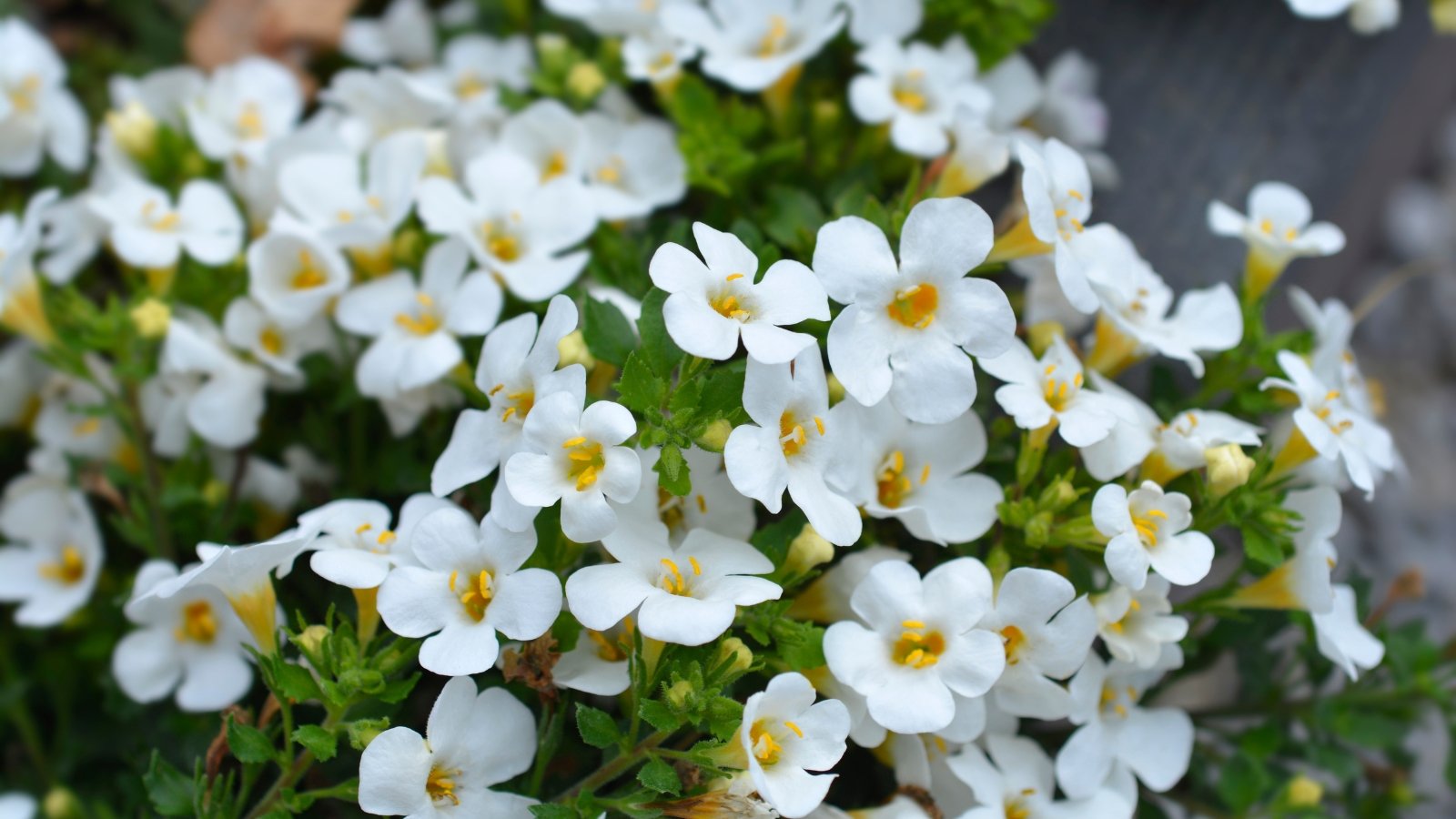
|
botanical name Chaenostoma cordatum |
Bacopa is generally thought of as a sun plant. But it does quite well in a shadier spot. It can not be planted in full shade, but it will look great in partial shade. A few hours of morning or late afternoon sun is all it needs to thrive. It requires less watering in shadier locations.
Bacopa is a trailing plant that has a flurry of white or purple (depending on the variety) flowers. Try this romantic container combination using bacopa. Plant an airy palm in the center. Then layer some solid colored begonias, like ‘NonStop Rose.’ Then have the bacopa tucked underneath the begonias so it trails out the edge of the container.
‘Snowstorm Giant Snowflake’ is a large variety with big flowers and lots of vigorous branching stems. It’s great for hanging baskets.
Boston fern

|
botanical name Nephrolepis exaltata |
Boston Ferns are a great addition to shady containers. They have big lush ferny foliage that can be part of a container or fill the entire container. They are inexpensive and readily available at most garden centers.
You can purchase Boston ferns in all different sizes. The large ones look great in hanging baskets or large containers all by themselves. Hang them along porches for that classic American loom. Or, I sometimes find them in smaller containers, and I will use them to fill in gaps in my shade containers. They look great beside big lush begonias or fuchsias.
For an interesting twist on a regular Boston fern, try a variety known as ‘Tiger Fern’, which features stripes of light and dark green through the foliage. You can play up the striped features by planting it next to a chartreuse shade plant, like ‘Wasabi’ coleus.
Brocade Geranium

|
botanical name Pelargonium x hortorum |
While geraniums are mostly suited for sun, brocade geraniums can be planted in the shade. This is because they have beautiful foliage. Brocade geraniums feature large ruffled leaves with intricately colored stripes and patterns on them. They do flower, but I think the foliage is what makes them stand out.
I plant brocade geraniums as a filler plant for containers. Plant a thriller plant in the center, like a lemon cypress. Then plant brocade geraniums and some begonia or impatiens in between the geraniums. Add some German ivy or English ivy to finish the look.
‘Vancouver Centennial’ is a variety I use often. It has chartreuse margins with a blotch of dark red in the center. In shadier conditions, it is a lighter chartreuse with less of a red blotch in the center. It is a unique foliage plant that always draws attention.
Browallia
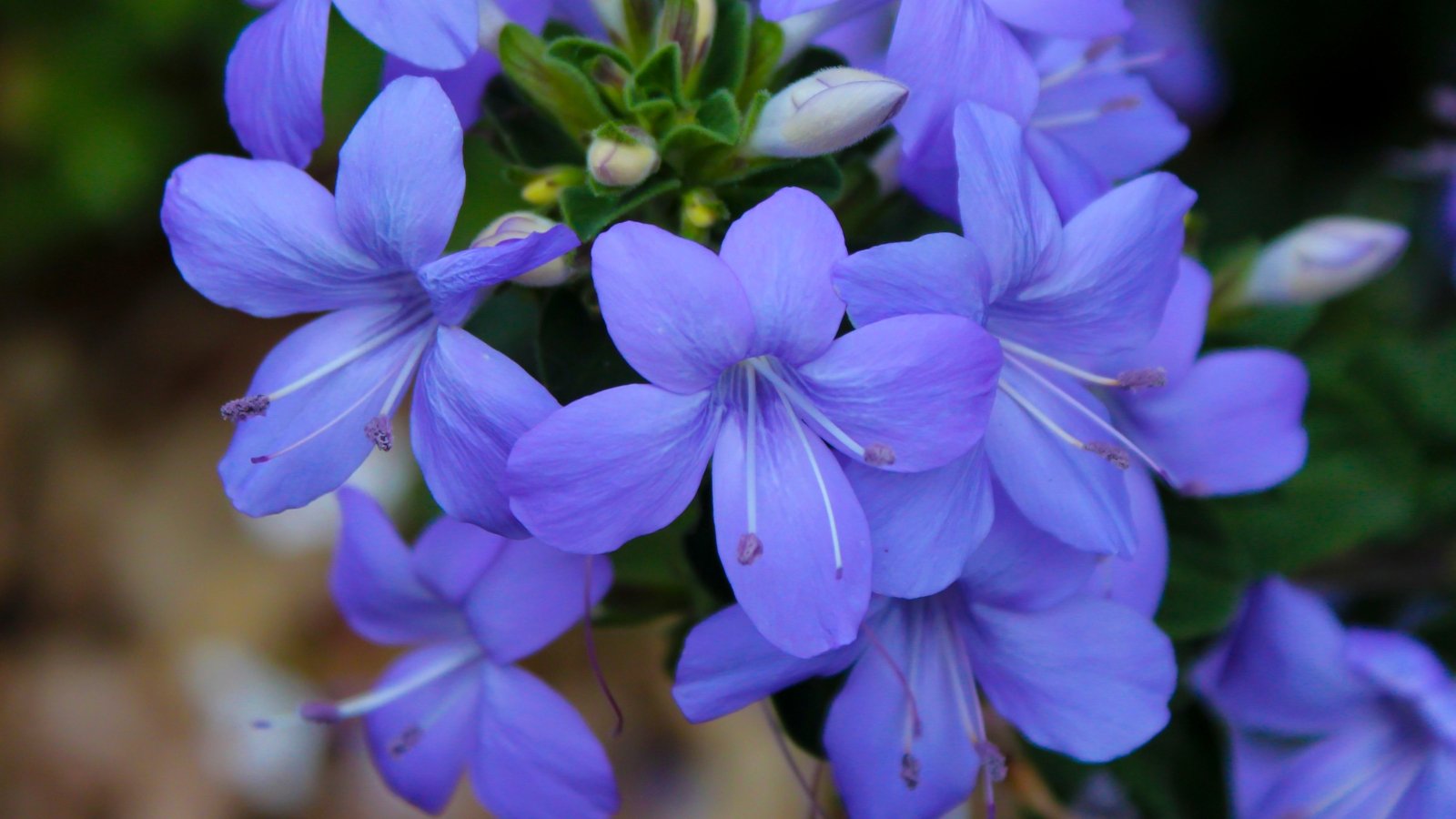
|
botanical name Browallia speciosa |
Browallia is a sweet woodland flower that thrives and blooms in the shade. It has small green leaves and five-star flowers that come in purple and white.
I like to keep things simple with this flower. Just a simple palm, green dracena spike, or sansiveria for some height. Then, plant a fluffy mass of browalia underneath. Try mixing white and purple varieties in the same container for a more whimsical look.
‘Endless Illumination Bush Violet’ is the gold standard variety in my opinion. It blooms large flowers throughout the season without any deadheading required.
Brunnera
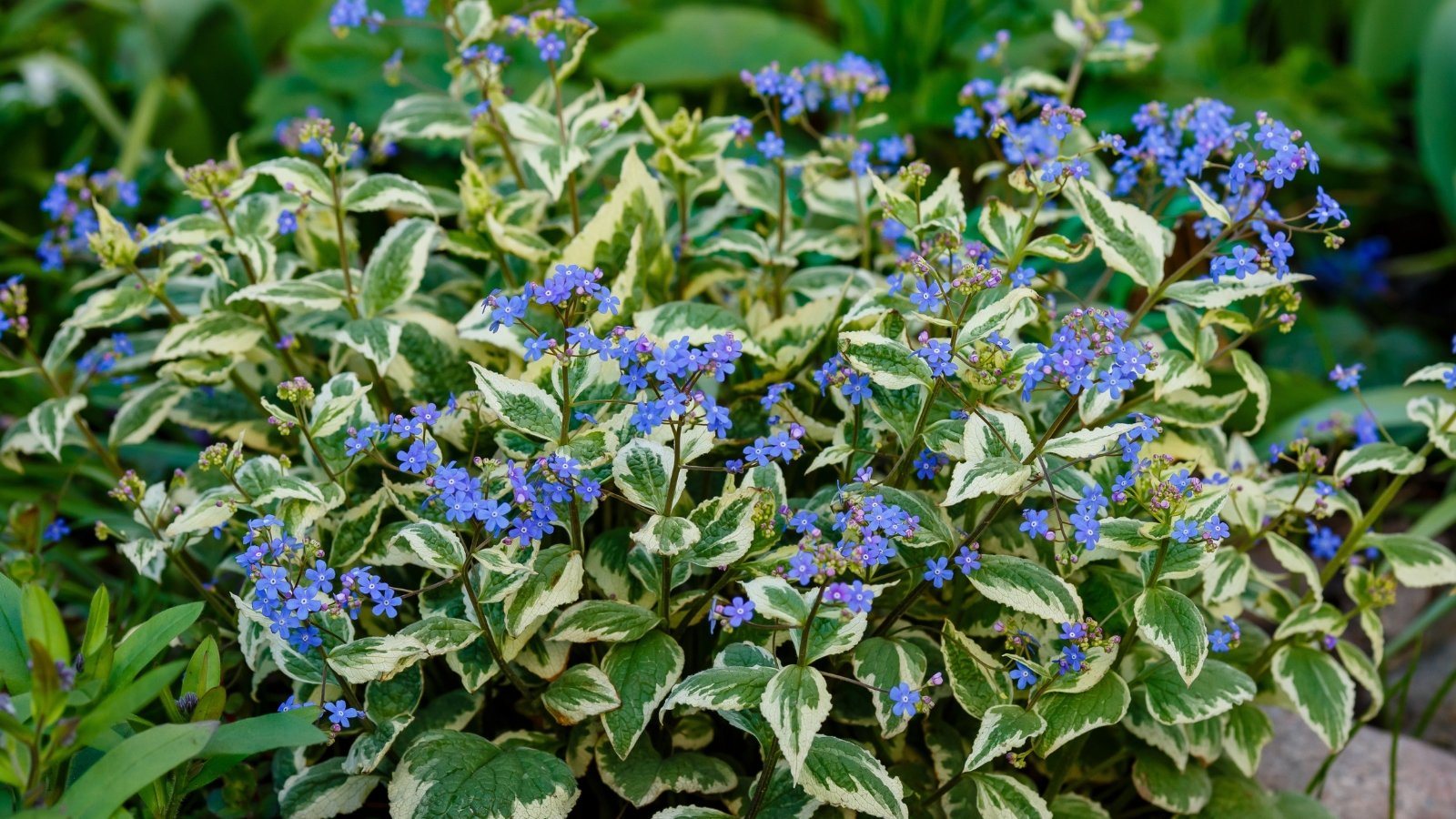
|
botanical name Brunnera macrophylla |
Brunnera is a hardy perennial that works great in shady containers. It has lovely heart-shaped leaves and small blue flowers in the spring.
I like adding it as a filler plant with other flowering plants. Since brunnera isn’t in bloom for very long, it’s mostly a foliage plant. Tuberous begonias, bacopa, and/or lobelia would be pretty companions. Use a feature palm or alocasia in the center for a large, lush container display.
‘Jack Frost’ brunnera is my favorite variety. It features big heart-shaped leaves with frosted white leaves and green veins. It looks great even when it’s not in bloom.
Caladium
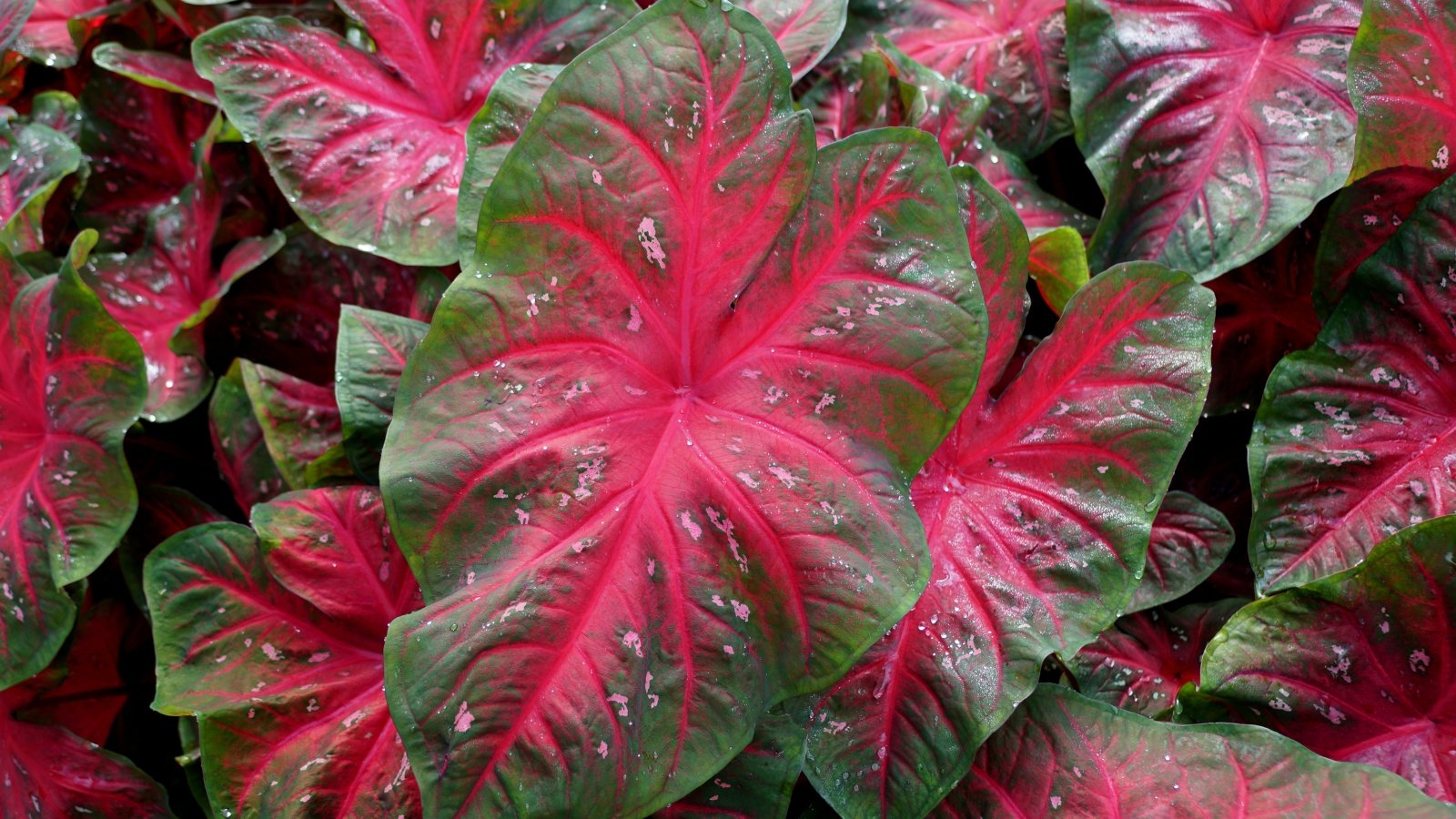
|
botanical name Caladium bicolor |
Caladium is a colorful foliage plant that is sure to brighten up any shady container in your garden. These tropical plants feature glossy heart-shaped foliage that comes in lots of colors and patterns depending on the variety.
Caladiums can be used as a filler plant in a container, using a mixture of other plants to fill in with it. Or, if you have a larger variety or a smaller container, it can also act as the feature plant. It can stand alone in a container, or you can plant ivy or other trailing plants underneath it.
‘Classic Pink’ is one of my favorite varieties. This pretty plant features dark green margins and a deep pink center. It is spectacular enough to be in a container on its own. It can be brought indoors over the winter and kept as a houseplant.
Calathea
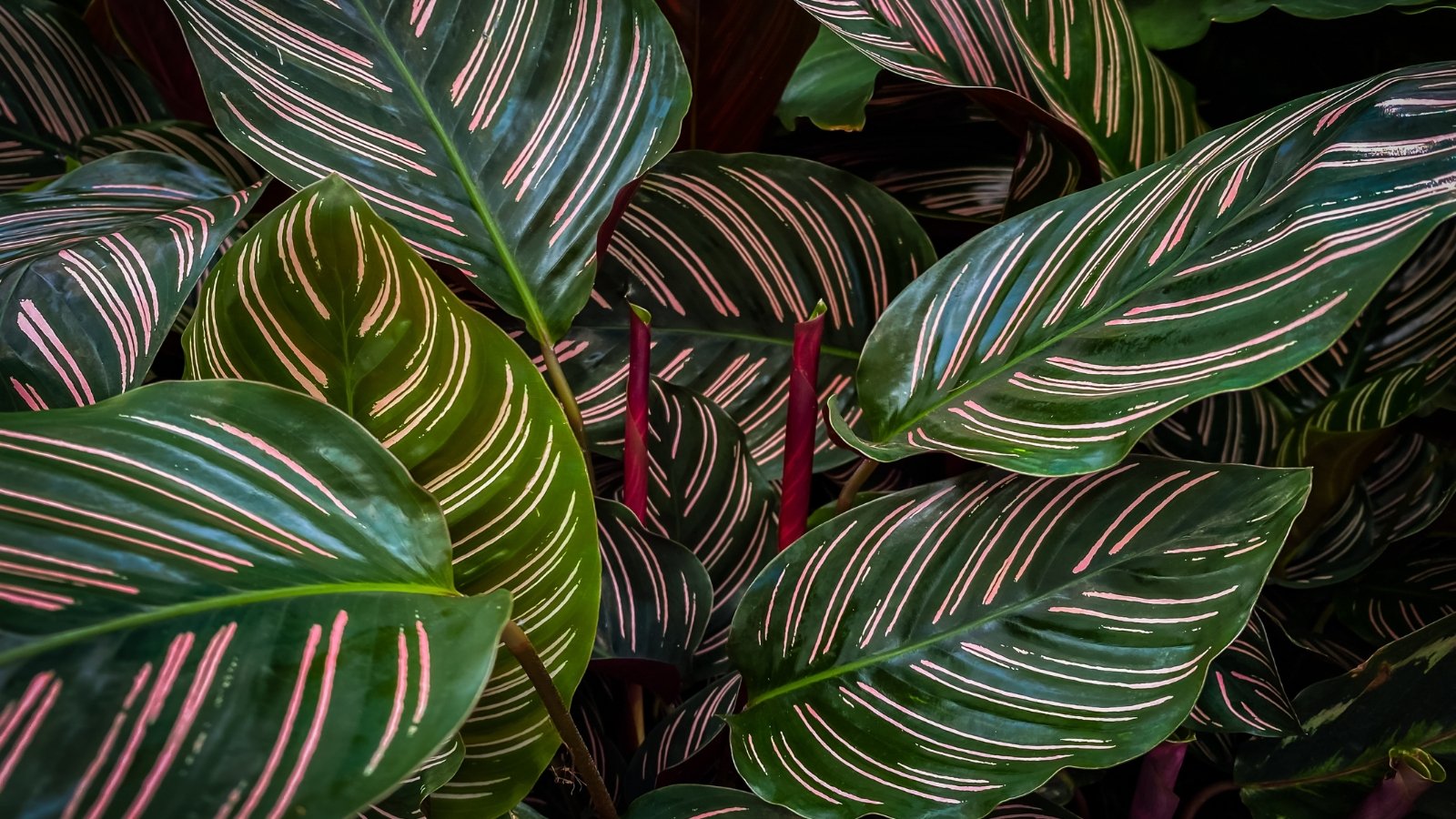
|
botanical name Calathea crotalifera |
Calatheas can be a finicky plant. I find them hard to maintain indoors. However, if you place them in a container arrangement outside I find they will last for a few months just fine. So if you are swapping your arrangements out seasonally, calatheas make an interesting container plant.
They have intricately colored and patterned foliage that are a beautiful addition to an arrangement. I love plants that don’t rely on flowers in shady spots. Especially the deep shade where flowers don’t bloom. So if you have a really shady corner, consider adding a calathea.
I like rattlesnake calatheas. They have long, narrow leaves that are light green with dark green markings on them. Then the underside is a burgundy hue. The foliage adds an interesting texture and color to the mixed container. Consider adding other tropicals like spider plants, rex begonias, coleus, and ivy.
Calibrachoa
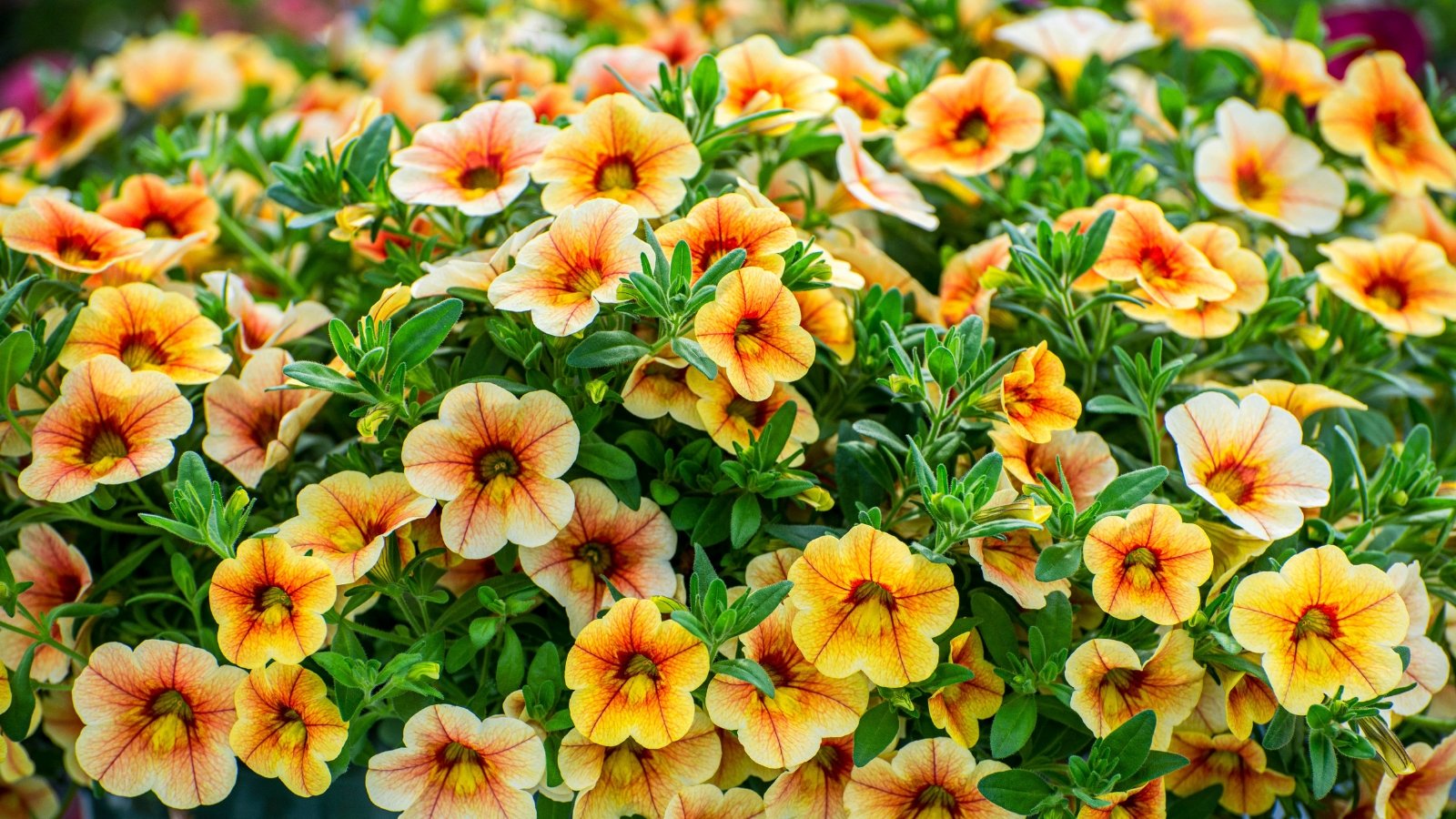
|
botanical name Calibrachoa x hybrida |
Calibrachoa, or million bells, are generally considered a full sun annual. But I have been using them in part shade containers successfully for years.
Calibrachoa come in a wide variety of colors, making them a great flower to add to mixed containers. I think the trick for using them in shadier locations is to choose ones from the nursery or garden center that already have lots of flowers on them. Then, make sure they aren’t in the deep shade. They won’t grow as fast, but the flowers will last a long time.
I really like using white calibrachoa such as ‘Callie White’ or ‘Kabloom White’ in shade pots to brighten them up. Mix them in with areca palms and tuberous begonias, along with lots of German ivy for a lush all-white and green look.
Coleus
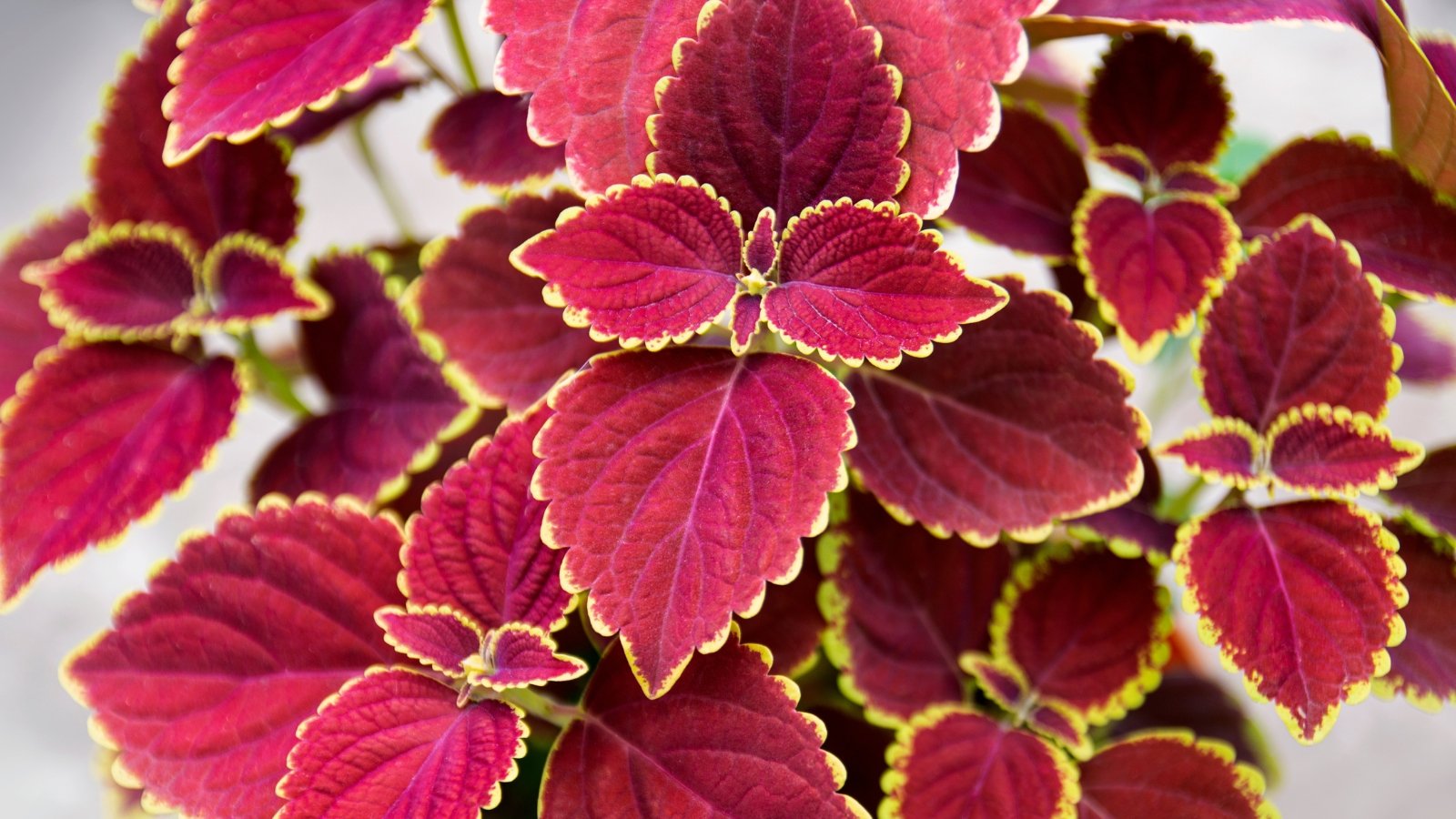
|
botanical name Coleus spp. |
Coleus is the perfect plant for shady pots. It has bright foliage and doesn’t rely on flowers for color, so it can be placed in the shadiest of containers. They come in an array of colors: pink, yellow, red, and green. And various patterns and combinations.
Coleus is versatile in containers. You can get a large variety, like ‘Fishnet Stockings’ that can be the thriller plant in the center. Then layer impatiens, lobelia, and ivy underneath it to finish off the look.
Or you can plant a large, showy plant, like a bird if paradise, or a Chinese fan palm in the center or back of a container. Then layer smaller ‘filler’ sized coleus such as ‘Wizard Mix’ underneath it. This creates a colorful tapestry, I usually finish it off with a bright trailer, like golden creeping Jenny, or a bright green ‘Margarita’ sweet potato vine.
Finally, you can even use coleus as a trailing plant. ‘ColorBlaze Chocolate Drop’ is a low-growing variety that will spill out of containers. Plant a container with a dracaena in the center, then layer ‘Sonic Sweet Purple’ New Guinea Impatiens underneath it. Then add the ‘ColorBlaze Chocolate Drop’ Coleus and some green German ivy to trail out.
Coral bells
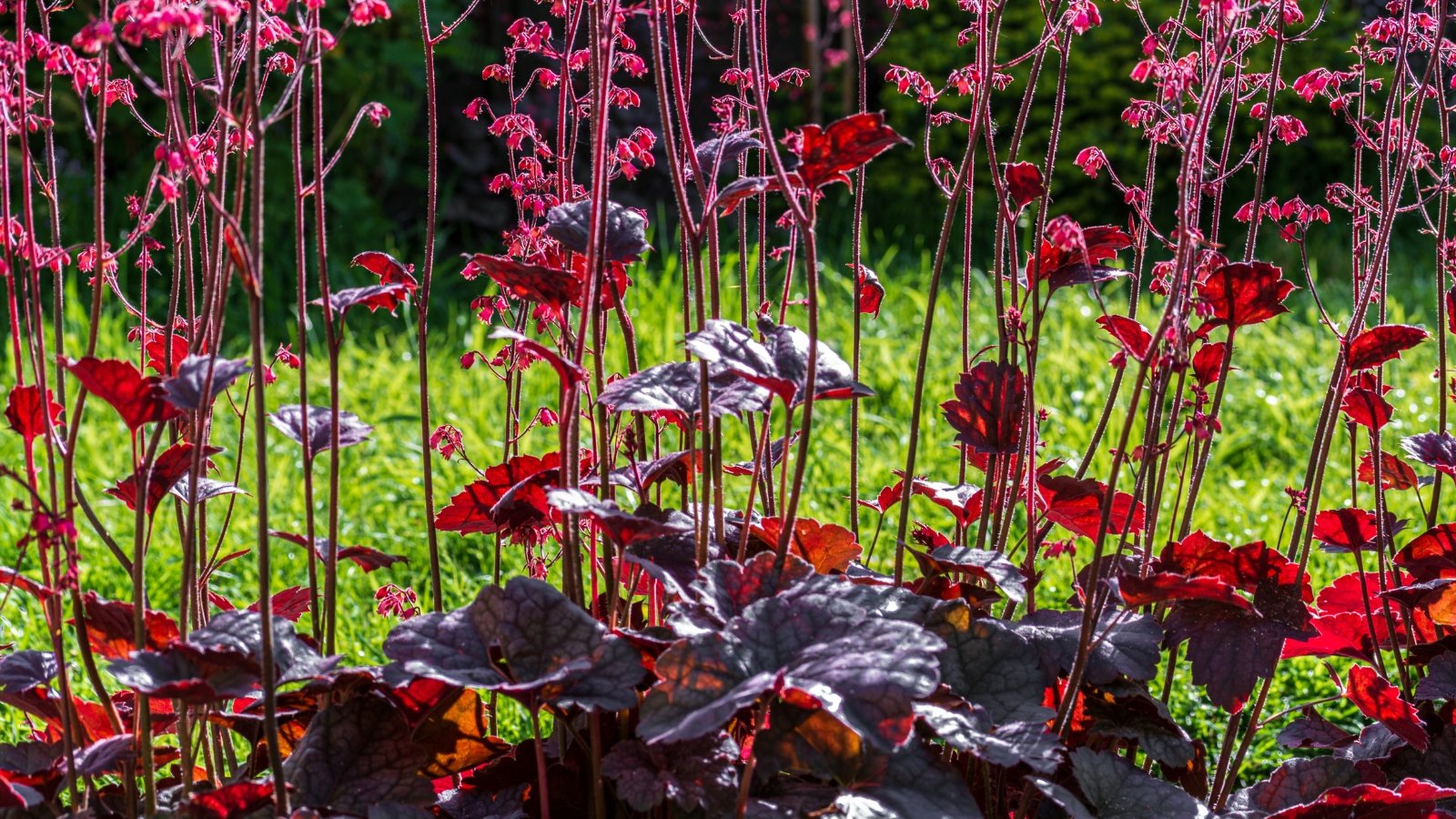
|
botanical name Heuchera spp. |
Coral bells are a hardy shade plant that has colorful foliage. It makes a great addition to shade containers. You can find coral bells in a variety of colors, like light green, deep purple, and golden caramel.
I will use coral bells as either the ‘thriller’ or ‘filler’ plant in a container. You can use a large ‘Grande Black’ Heuchera in the center of a container. This deep purple variety is a statement on its own. Then, plant some golden creeping Jenny underneath for a bright splash of color.
I like to use a ‘Georgia Peach’ coral bell in an autumn container. This warm caramel coral bell is the perfect fall color. Plant it in with a Lemon Cypress, pansies, sweet alyssum, and ivy for a shady fall container.
Dragon Wing Begonia
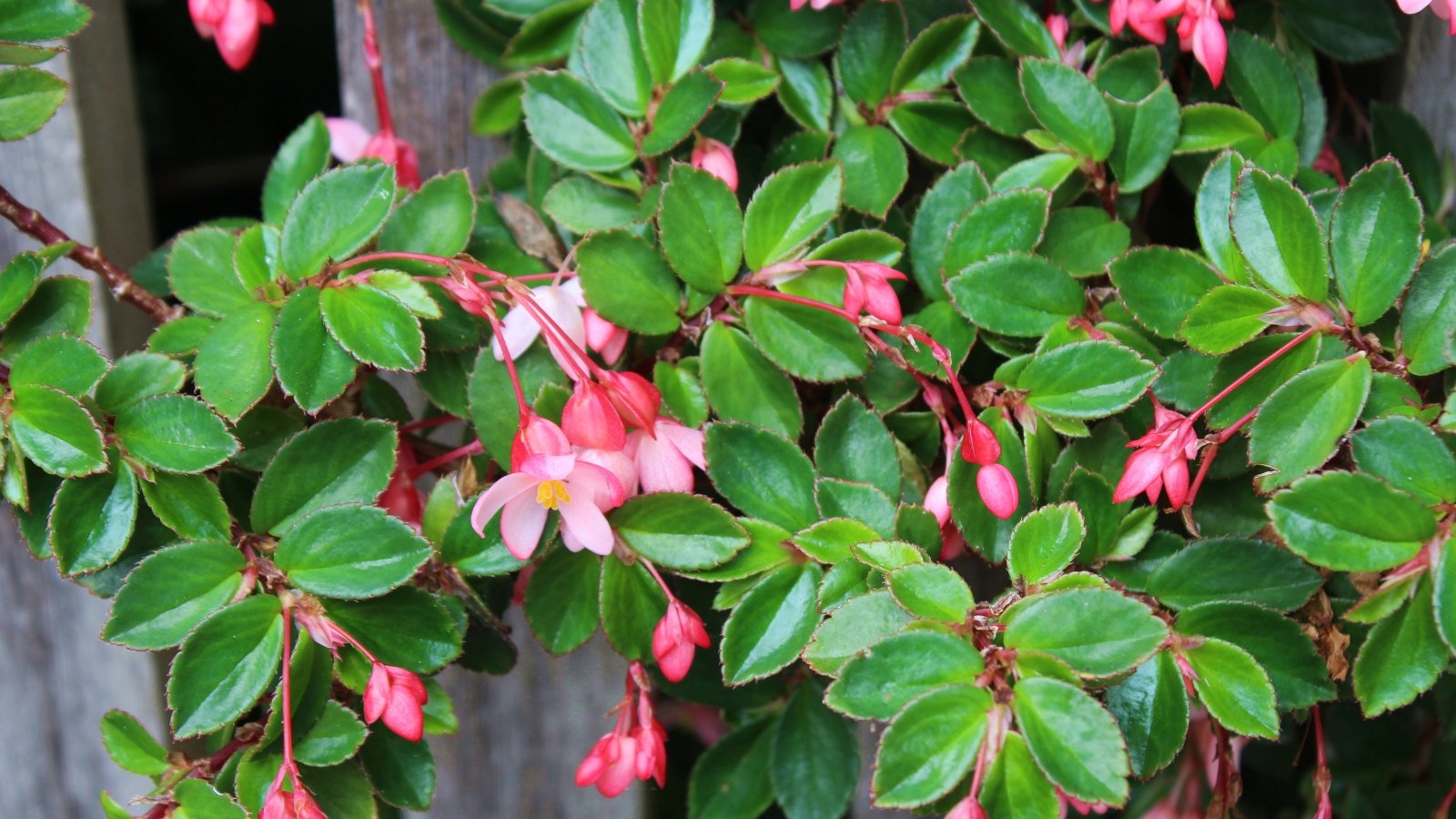
|
botanical name Begonia x hybrida |
Dragon wing begonia is a type of fibrous, or wax, begonia. But it needs its own category on its list because it takes on a unique role in garden containers. Dragon’s wing begonias have thick glossy leaves that are narrow and pointed. Then it has small clusters of flowers that hang down.
In a container, you can use dragon wing begonia in a few different ways. They look great on their own in a hanging basket. The glossy leaves fill out the pot, and the flowers trail downwards. Or you can use them as a filler and trailing plant. Plant them at the edge of your container, and they will grow up and fill the pot as well as trail downwards.
‘Dragon Wing Red Bronze Leaf’ has deep bronzer foliage and bright red flowers. It looks great paired with chartreuse foliage, such as ‘Vancouver Centennial’ geraniums or ‘Lime Rickey’ coral bells.
Fuchsia
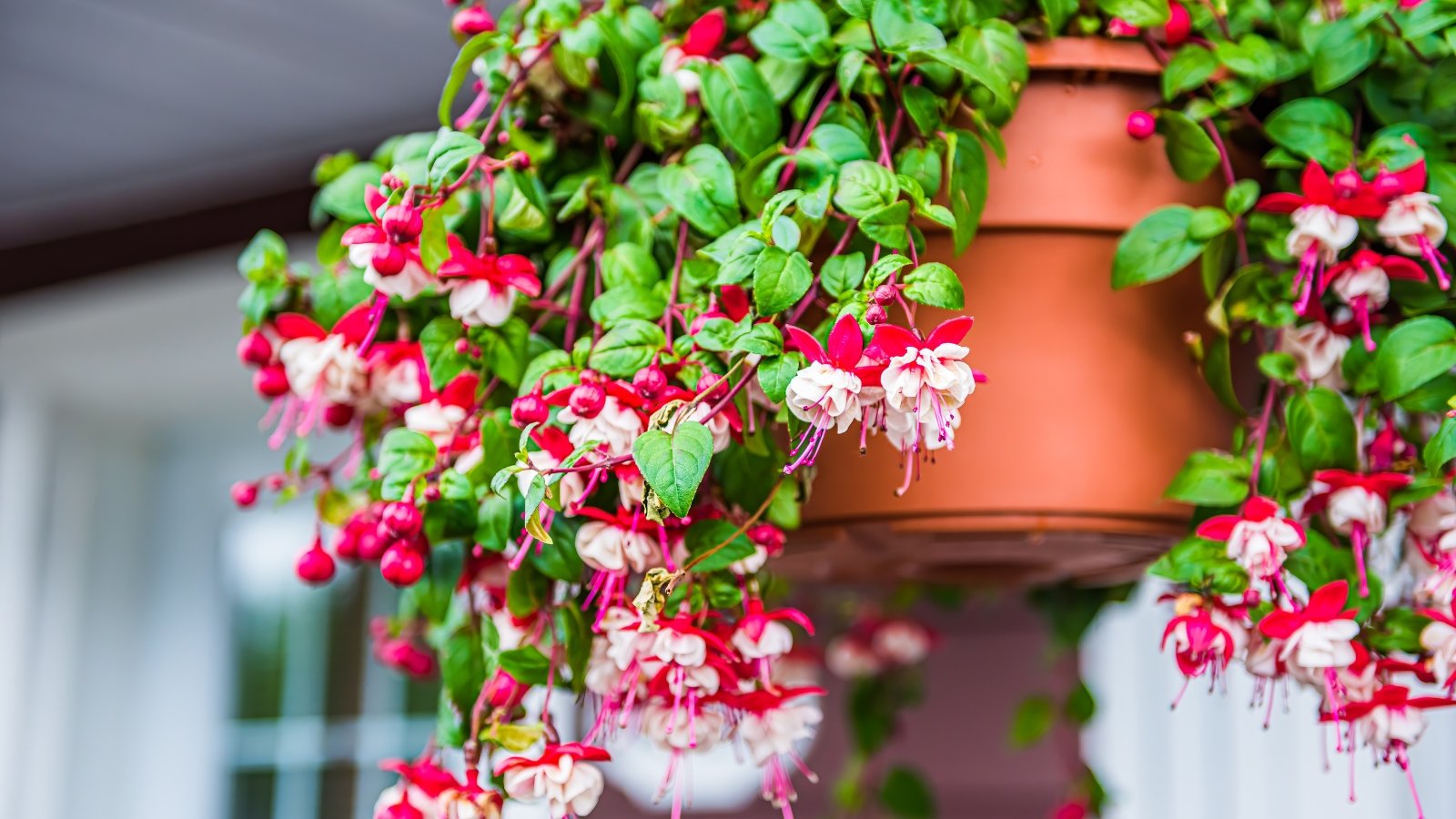
|
botanical name Fuschia spp. |
Fuchsias are the most delicate, lovely flowers that look like pretty ballerinas dancing off the vine. They come in so many color combinations that you can customize your container to match your theme perfectly with fuchsias.
Fuchsias are so showy, I think less is more when using them. That is to say, I usually don’t add many more flowers to my container when I’m using fuchsias. A simple hanging basket filled with fuchsia is perfect. Or I will plant a big container with a simple green dracaena or palm in the middle and fill in fuchsias underneath.
‘Charm Rose Purple’ is a variety with large flowers. It has pink outer petals and a large purple ruffle center. ‘Pink Marshmallow’ is a pure white variety with the slightest tinge of pink. It would make a great choice for wedding containers.
Golden Creeping Jenny
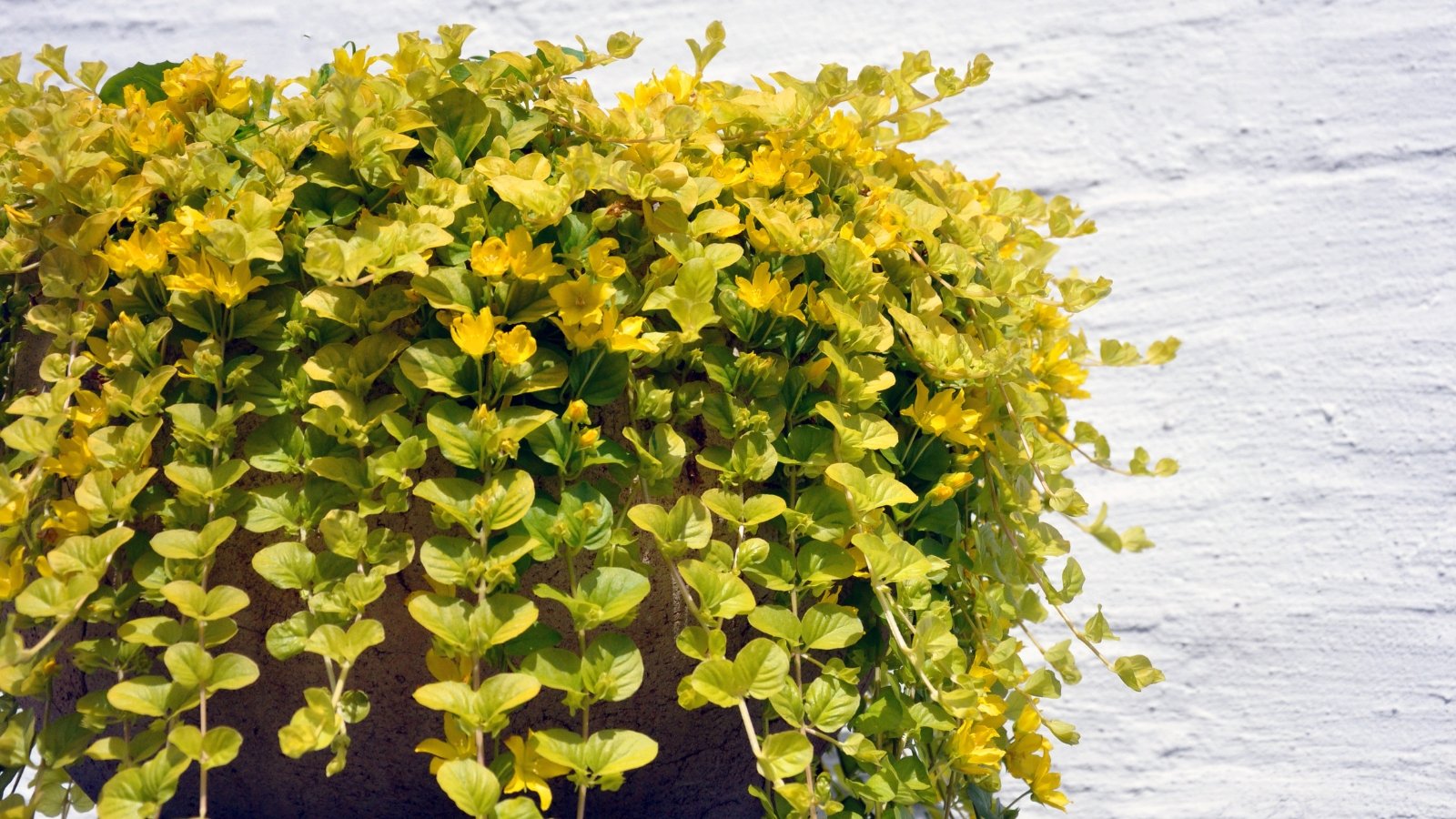
|
botanical name Lysimachia nummularia ‘Aurea’ |
While creeping Jenny can be invasive and not a great choice for in the garden. The golden variety is one of my favorite trailing plants for shady containers.
While golden creeping Jenny may not be the star of any container design, it is that extra touch that makes them really pop. The golden chartreuse color is perfect for pulling out the yellow margins of other plants, like coleus and hostas. It also really brightens up containers that have a lot of dark plants like deep purple coral bells or rex begonias.
Golden creeping Jenny hangs down the sides of pots beautifully. It is also easy to squish one into an already full container. It is a great finishing touch that I use in almost all of my shade containers.
Hosta
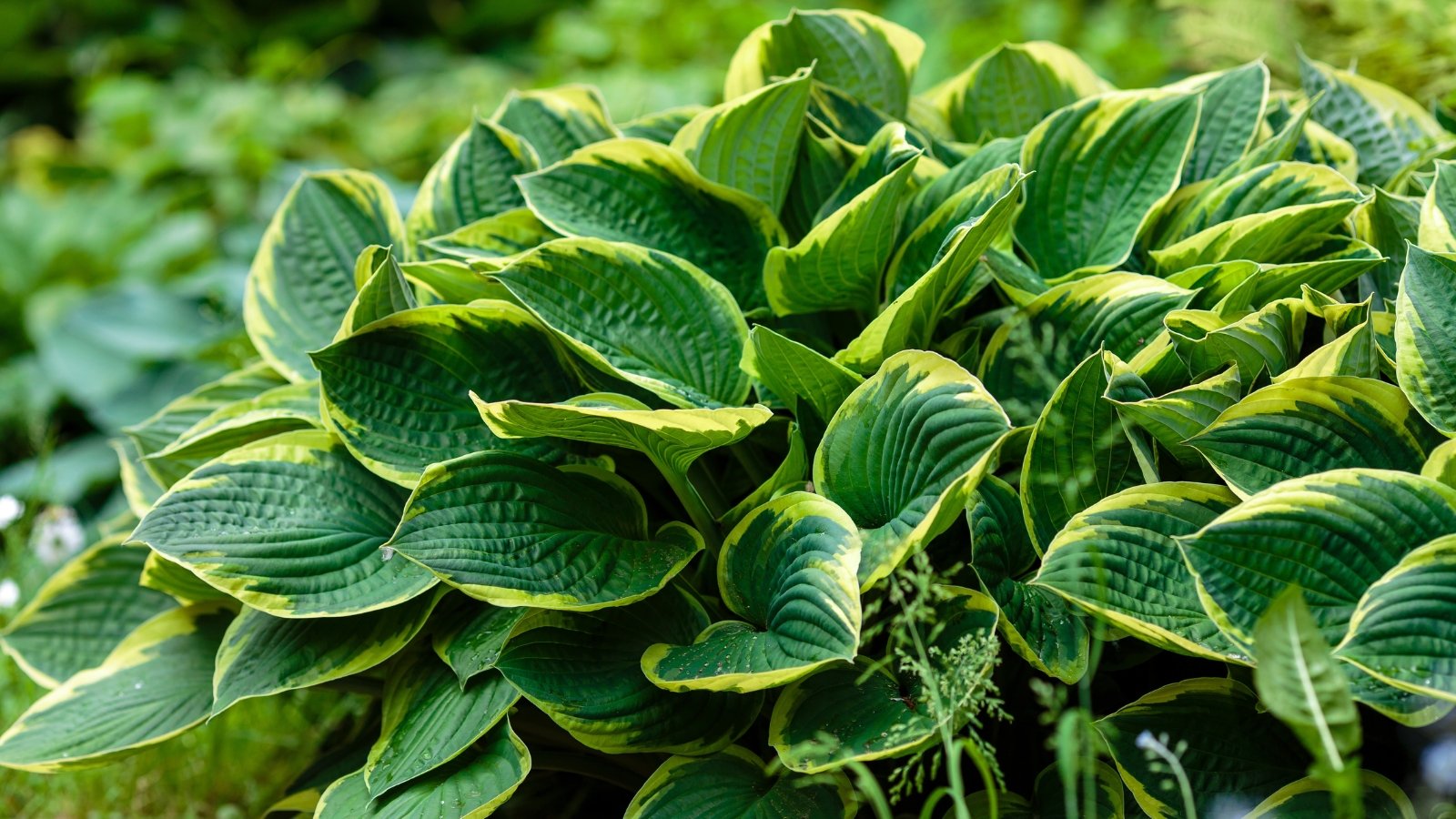
|
botanical name Hosta spp. |
If you want to add color and interest to your pots without any flowers, hostas have you covered. You can make entire container designs using just hostas. There are so many unique varieties to choose from. They have large-brimmed foliage that comes in various shades of green. Some are simple, and others have elaborate patterns on their leaves.
Hostas can be ‘thriller’ plants in your containers depending on which variety you choose. ‘Abiqua Drinking Gourd’ hosta is a large dusty blue hosta. It features upturned leaves that are shaped like little bowls. This blue foliage is well-suited to very shady locations. It is large enough to be a feature plant. Plant little ‘Infinity White’ impatiens around the base of it for a cute woodland-inspired container.
Hostas can also be the ‘filler’ plant in your containers. Choose a smaller hosta, like ‘Raspberry Sundae’, which features white and green leaves with bright red stems. It adds a splash of color to any shady design.
Hydrangea
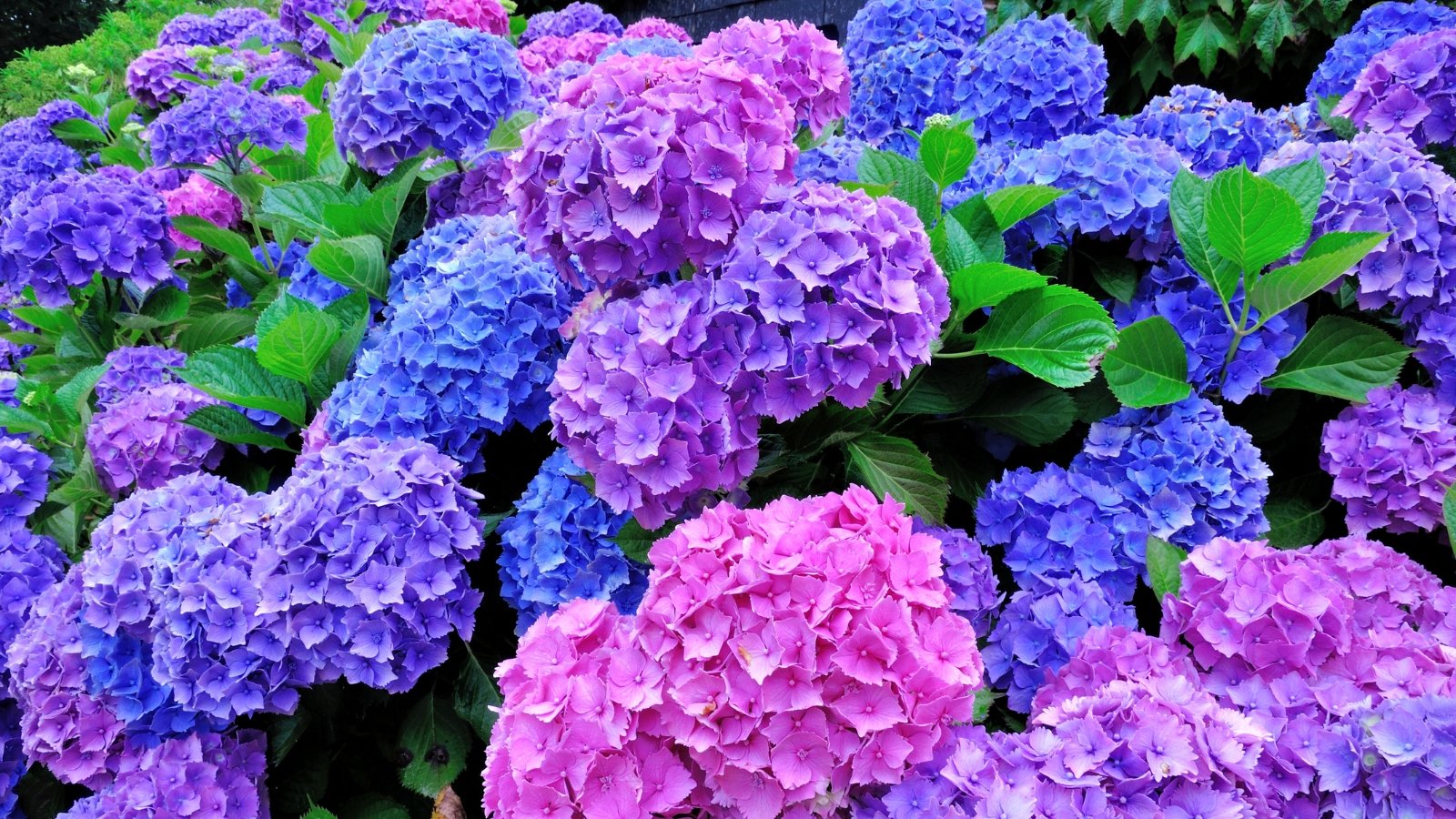
|
botanical name Hydrangea spp. |
The giant snowball flowers on hydrangeas make them a showstopper in any container. While most hydrangeas don’t work in full shade conditions, they do perform well in part shade. Morning sun is perfect for hydrangeas.
Hydrangeas steal the show in containers. I like to keep everything simple when using them. Just plant a big full hydrangea in the center and then add some bacopa or ivy underneath it.
‘Nikko Blue’ hydrangeas have large balls of flowers that will change color depending on the soil. This is really fun to experiment with when working with containers because it’s easy to control pH levels in a container. The more acidic the soil, the more blue it will be. In more alkaline soil, the flowers will take on a pink color.
Impatiens
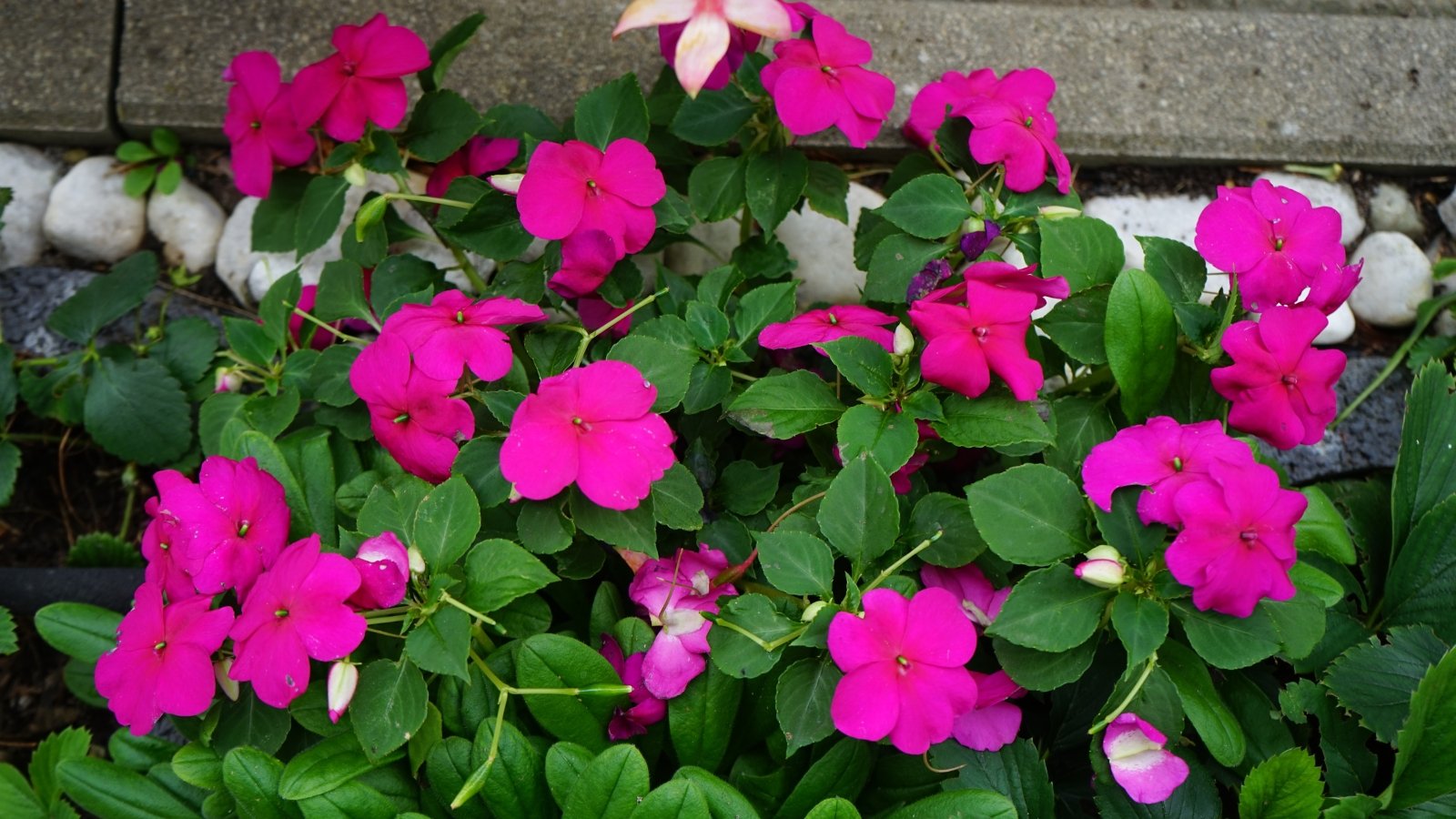
|
botanical name Impatiens walleriana |
Impatiens grow great in shade containers. They are short, bushy plants covered in cheerfully colored five-petaled flowers.
I use impatiens as filler flowers in containers often. They are low-lying, and they flower profusely throughout the season. This makes them the perfect thing to plant under large feature plants. They come in lots of different colors, including pink, red, orange, and white. So you can really customize your containers by using different colored impatiens.
I love brightening up the shade with bright white flowers. There are many varieties of white impatiens, including ‘Soprano White’. If you want a quick, easy elegant container, just plant white impatiens under an areca palm.
Ivy
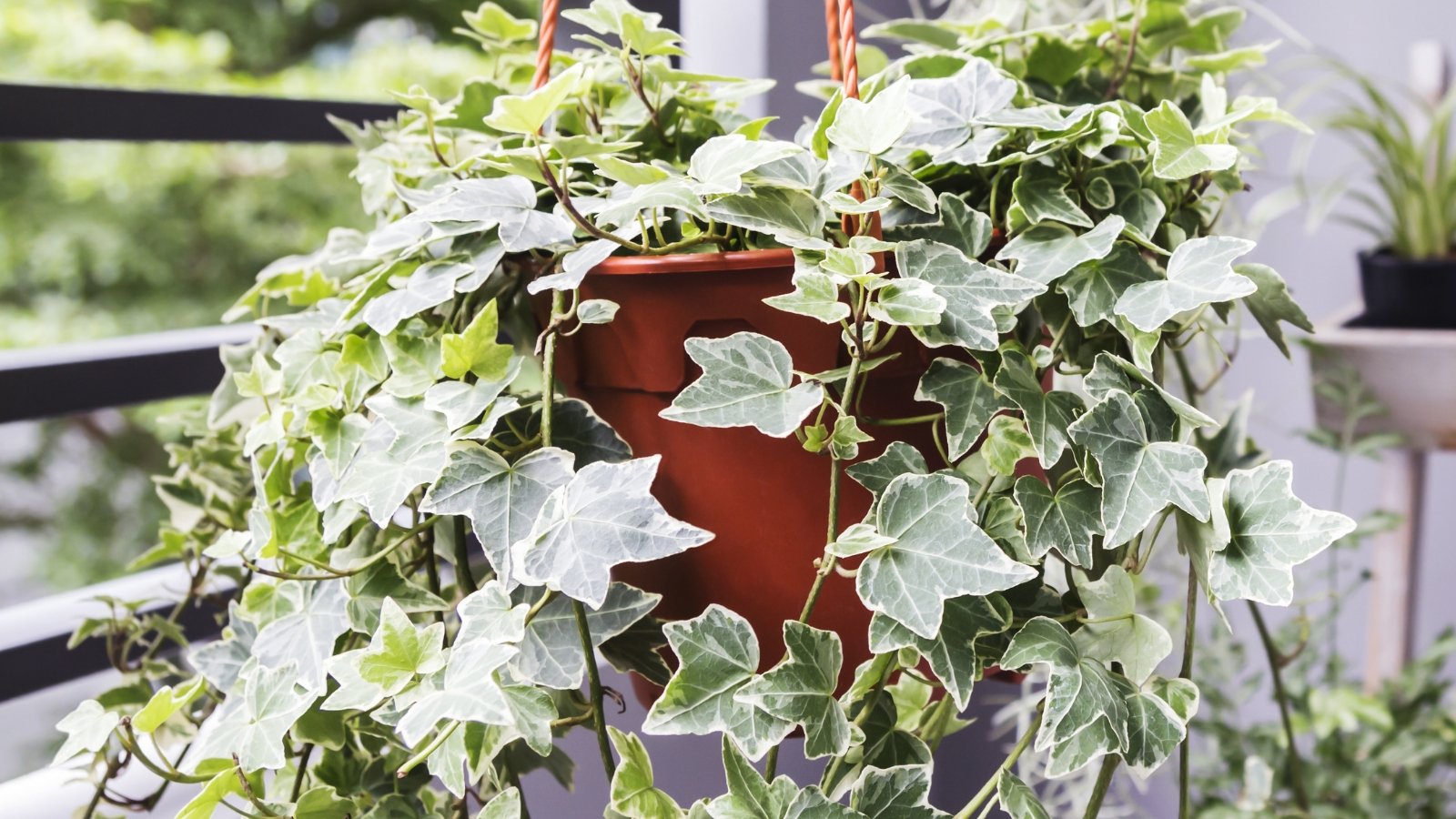
|
botanical name Hedera helix |
Ivy is another go-to plant when I’m creating shade arrangements. It trails down the sides of containers, which adds that finishing touch.
If you created a shade container and it just doesn’t seem quite finished, try tucking in some ivy. It really just ties everything together and makes your pot look finished. You can also grow ivy up trellises and cages to make them the feature in your container. I’ve used large ivy towers as my centerpiece and planted begonias and lobelia underneath.
If you want your ivy to give your containers an extra pop of color to tie everything together, consider using a variegated variety. ‘Gold Child’ features bright golden margins with various shades of green in the center. Containers are a perfect place for ivy, which can be invasive depending on the variety.
Japanese Painted Fern
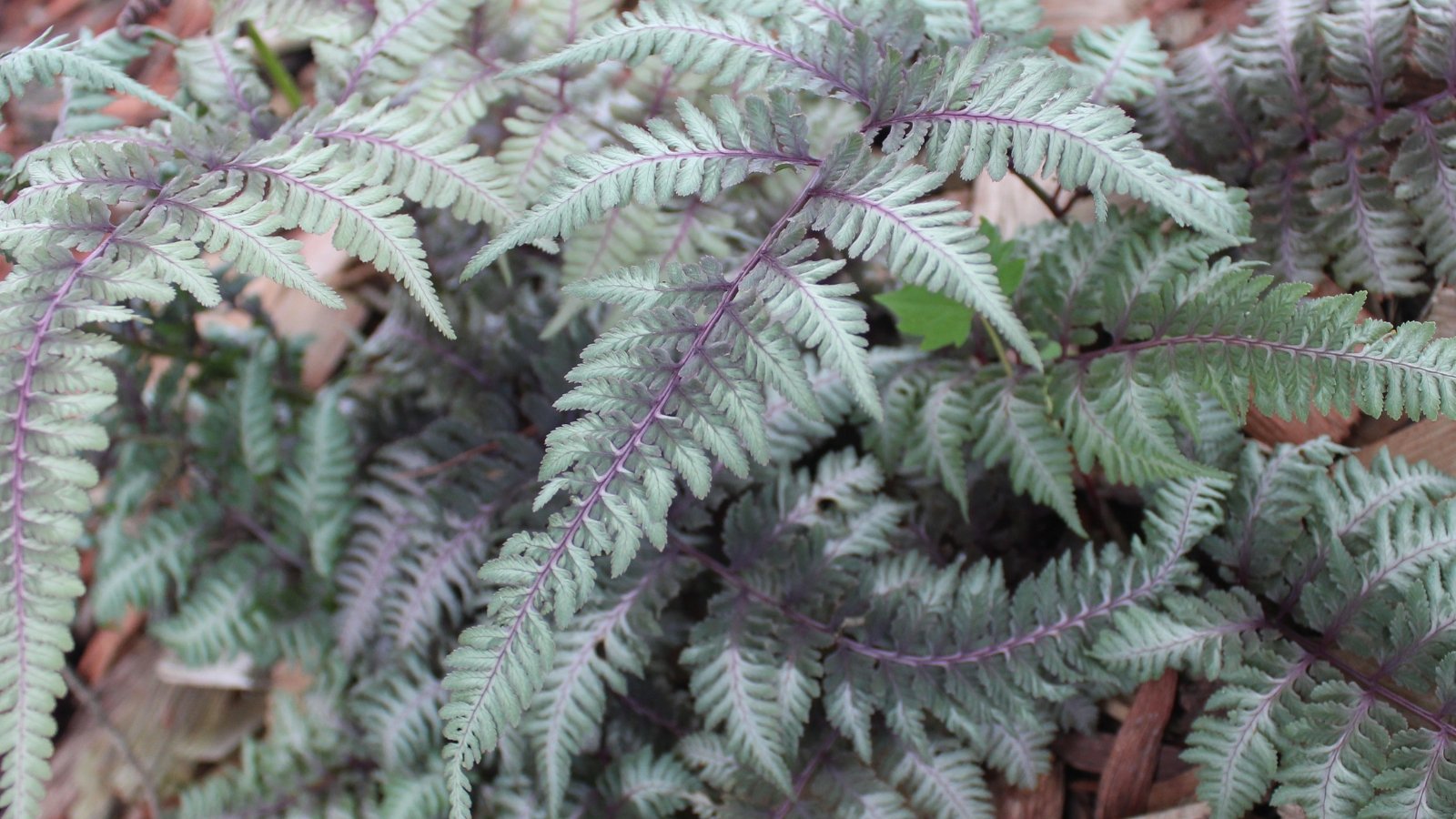
|
botanical name Athyrium niponicum var. pictum |
I love these Japanese painted ferns, which are a work of art both in the ground and in containers. They have silvery fronds with a purple center. They add color to your container without any flowers.
Japanese painted ferns are a wide and flat-growing fern. They make a great filler plant in containers. Use them to add color with their frosted foliage and purple accents. Highlight their textured and airy, feathery fronds.
They pair wonderfully with Rex begonias, such as ‘Shadow King’, which have the same color combination. But the rex begonia has wide-brimmed leaves, and the Japanese-painted fern has airy foliage. It’s a striking combination. They would look great in separate containers placed together in a grouping.
Lobelia

|
botanical name Lobelia erinus |
While lobelia is mostly thought of as a sun plant, I’ve been planting it in shadier containers for years with great success. I almost gave up on lobelia in containers. They always got brown and crispy. Especially as the summer keeps getting hotter and drier. So I started bringing them into my part shade containers, and they bloom profusely.
I have a container design I call “tropical punch”. I use a large tropical in the middle, like a palm, alocasia, or even a bird of paradise. Then, I plant tuberous begonias underneath. I like using pink or orange ones for this. Then, I will plant lobelia in between the begonias. Finish it off with ivy or golden creeping Jenny. It is so colorful and fun, just like tropical punch!
There are two main types of lobelia: trailing and upright. I mostly use the trailing varieties in containers. I like the ‘Regatta’ series a lot for puffy flowers that fill and spill over containers. The upright variety is used a lot to create borders in garden beds. But it also makes a nice upright filler plant in containers. The ‘Techno’ series is an upright variety.
New Guinea Impatiens
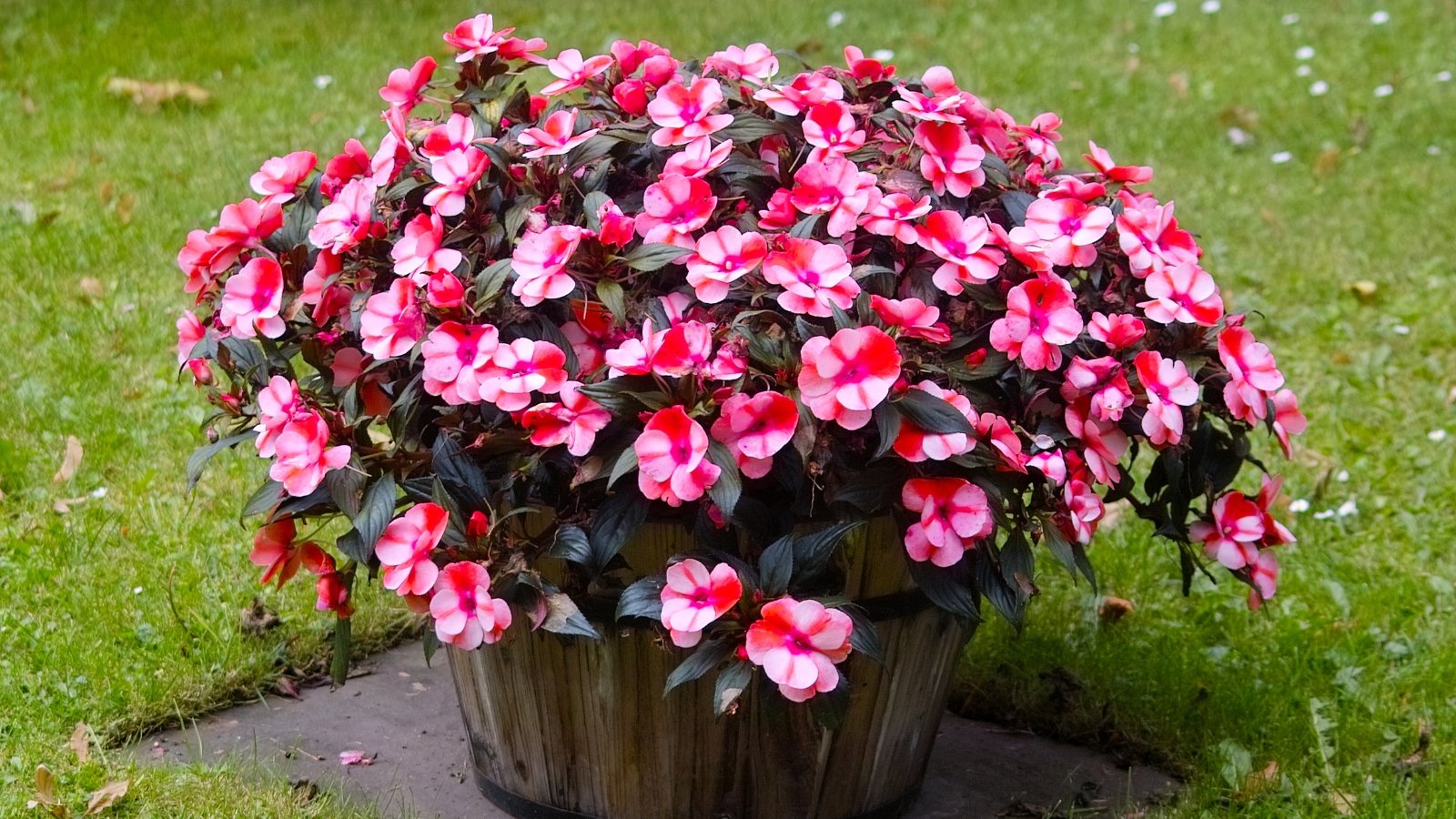
|
botanical name Impatiens hawkeri |
I like using impatiens in my containers, but sometimes you need a flower that is larger and bolder than the low bushy regular impatiens. That’s why I love New Guinea Impatiens. They are larger, more like tuberous begonias. They are covered in the tropical five-petalled flowers of impatiens.
You can plant New Guinea Impatiens in a pot all on its own, and it will fill in and look great. You can plant them in small containers and place them on shady tables for a pop of color. Or you can use them as a filler plant in a container arrangement. They grow large and lush.
‘Infinity Salmon’ is a fun variety. It has green foliage and soft salmon-colored flower with a deep pink center spot. It is a bright flower for a shady area.
Prince Tut Grass
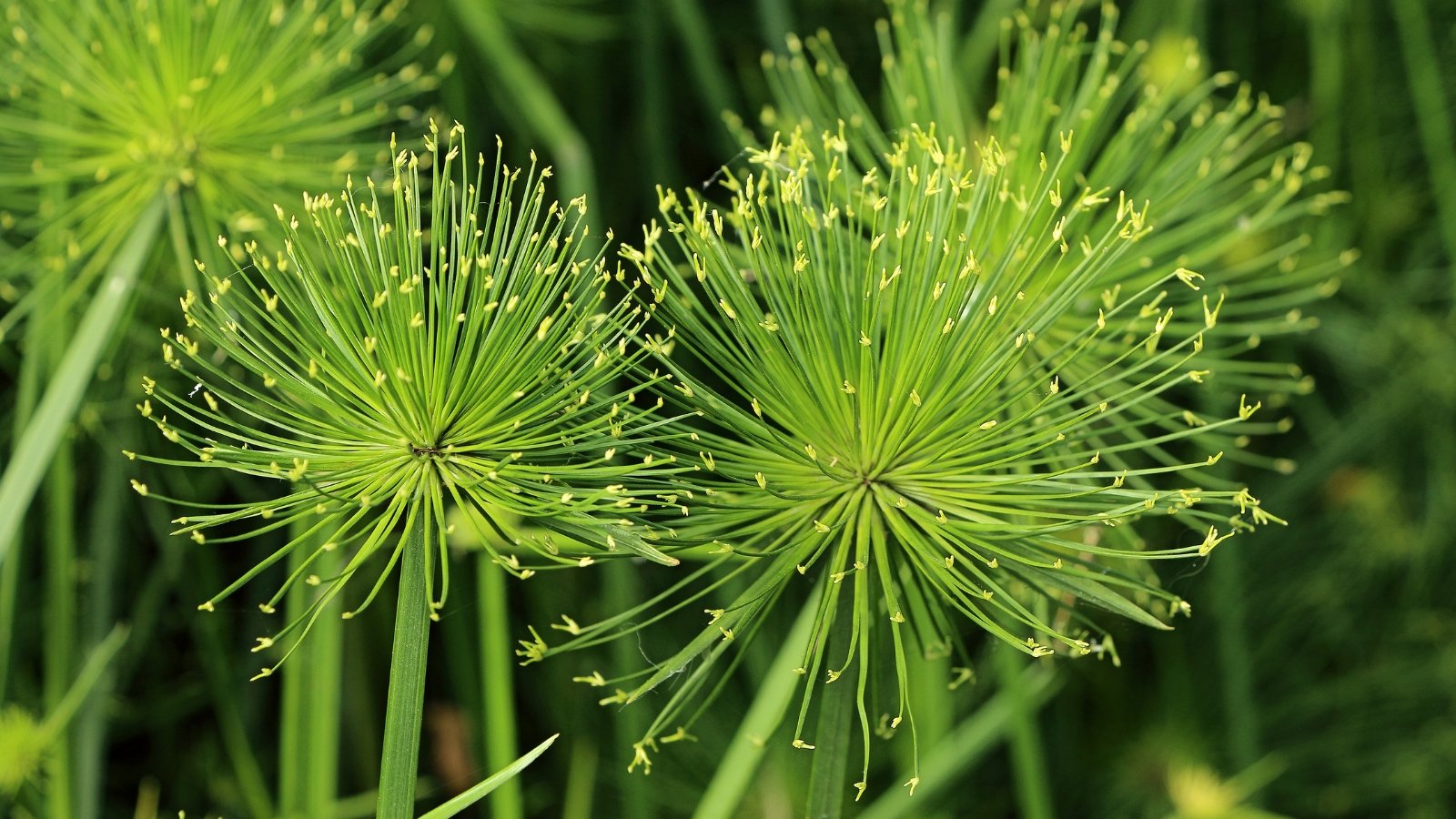
|
botanical name Cyperus papyrus ‘Prince Tut’ |
Prince Tut grass is an explosion of bright green foliage. It is the perfect centerpiece to add to your containers. It features long green stalks that explode into bright green poms at the top.
I plant Prince Tut into the center of my containers. Its bright green color and airy texture make it a feature plant. It is a water-loving plant. I like to pair it with lobelia, which also does not like to dry out. It can be placed in ponds and other water features as well.
Rieger Begonia

|
botanical name Begonia x hiemalis |
Rieger begonias are a cross between tuberous and wax begonias. They are larger and have big rosettes of flowers like tuberous begonias. Then, they have waxy leaves that sit on top of the plant like wax begonias. They are the best of both worlds and perfect for containers.
The flowers sit on top of the plant, and they last throughout the season. They rarely require deadheading. Rieger begonias are bred to bloom in winter months (although you can find them year-round now). I often find them in the floral department of grocery stores and with the houseplants in garden centers.
They are a great way to add a shot of color to a shady display. Sometimes I leave them in their nursery containers and just place them into my containers wherever there’s a gap. Then, once they finish blooming, I take them out and add something else.
Rex Begonia
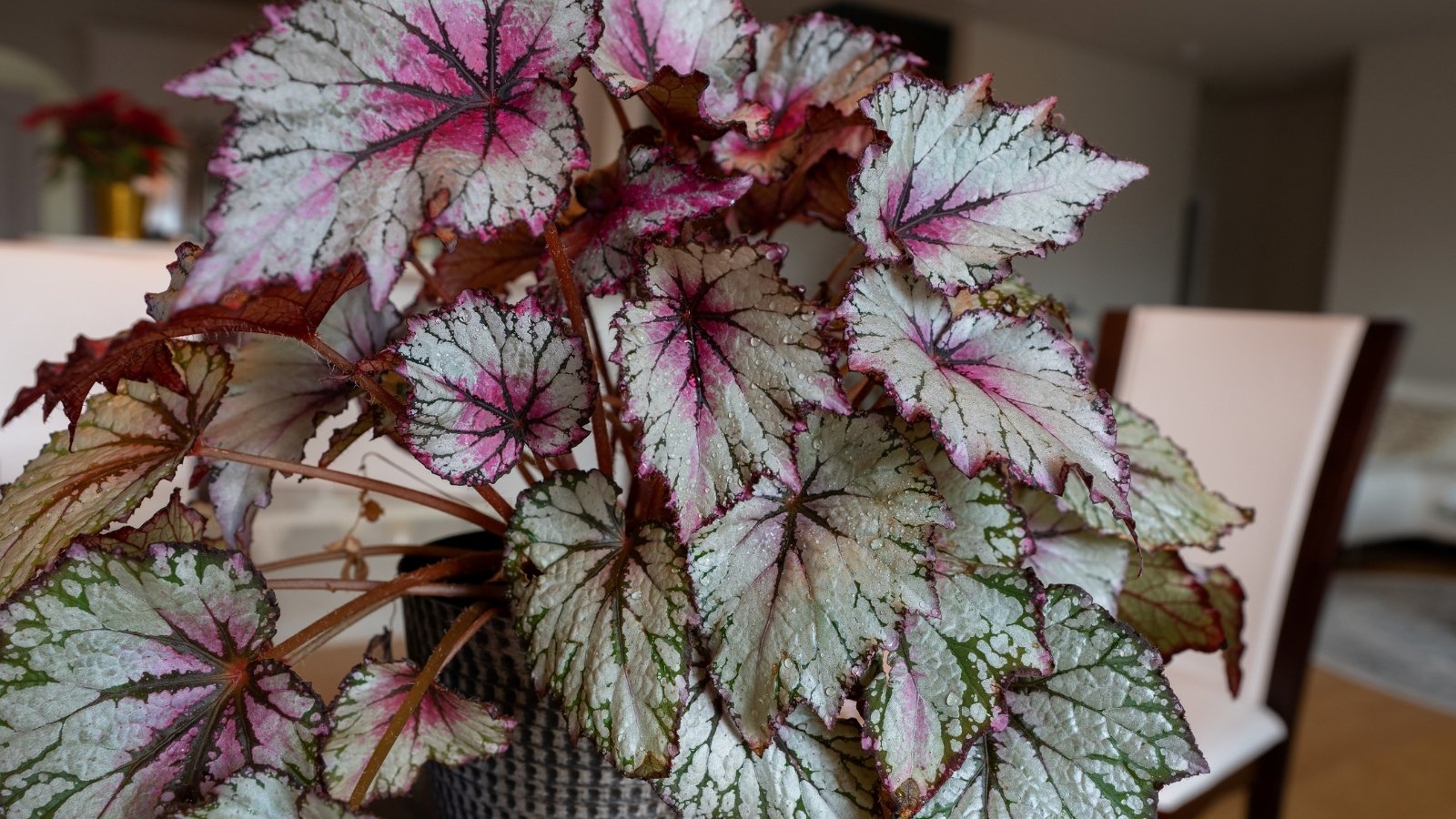
|
botanical name Begonia rex-cultorum |
Rex begonia is a colorful plant to add to shady containers. They come in so many patterns and colors. What I really like about them is they provide color through their foliage as opposed to their flowers. So you can put them in very shady containers, and they will add brightness and beauty without relying on blooms.
I like using Rex begonias as a filler plant in mixed-shade containers. Plant them underneath palms, ornamental bananas, or alocasias for an interesting pop of color. They can also stand alone in a container and be moved around wherever you want some lush and beautiful foliage.
‘Jurassic Silver Swirl’ and ‘Escargot’ are among my favorite varieties. They both feature intricate swirl patterns of silver and purple.
Sansevieria

|
botanical name Sansevieria spp. |
Sansevieria is mostly thought of as a houseplant. But it works great in containers. Its tall spiky leaves make it a great structural element in containers.
Sansevieria makes a great feature plant in shade containers. It looks great with begonias, impatiens, browallia, or torenia planted around it. Its broad spikes add structure, and the flowers around the base will soften it.
‘Black Gold’ is a great variety if you are looking to add color as well as structure to your container. It features dark green foliage with a bright golden margin. Plant it with some golden creeping Jenny to make it really stand out.
Spider plant
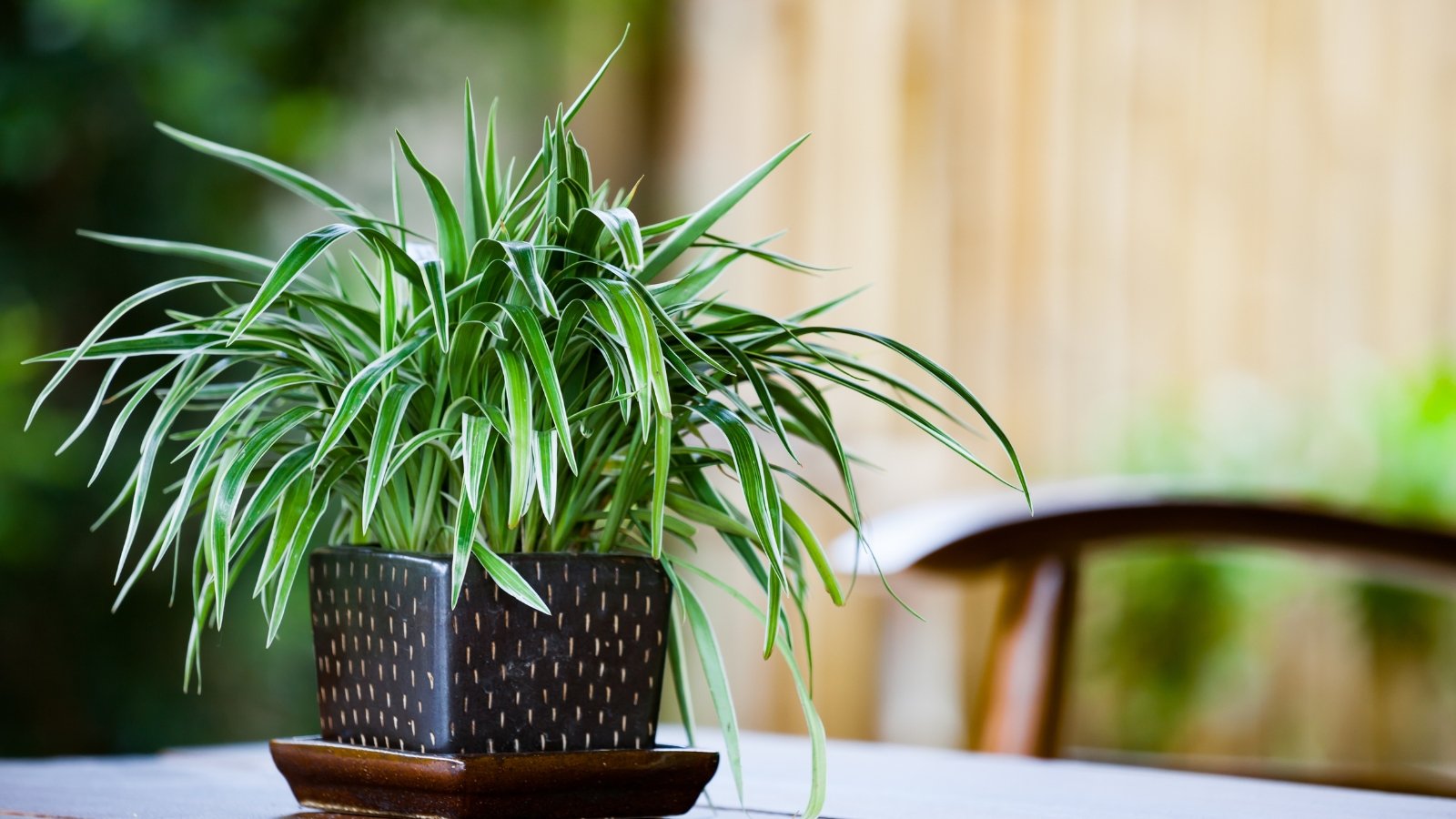
|
botanical name Chlorophytum comosum |
Spider plants are some of my favorite foliage plants to add to containers. They have green and white striped foliage and long spiky foliage. They will also make little baby spider plants by sending long shoots out with new spider plants.
I like to use spider plants as a filler/spiller plant. They start as filler, and then they start sending shoots of new spider plants over the sides of the container. I place these into almost any container arrangement because it adds texture along with interesting foliage color.
Sweet Alyssum
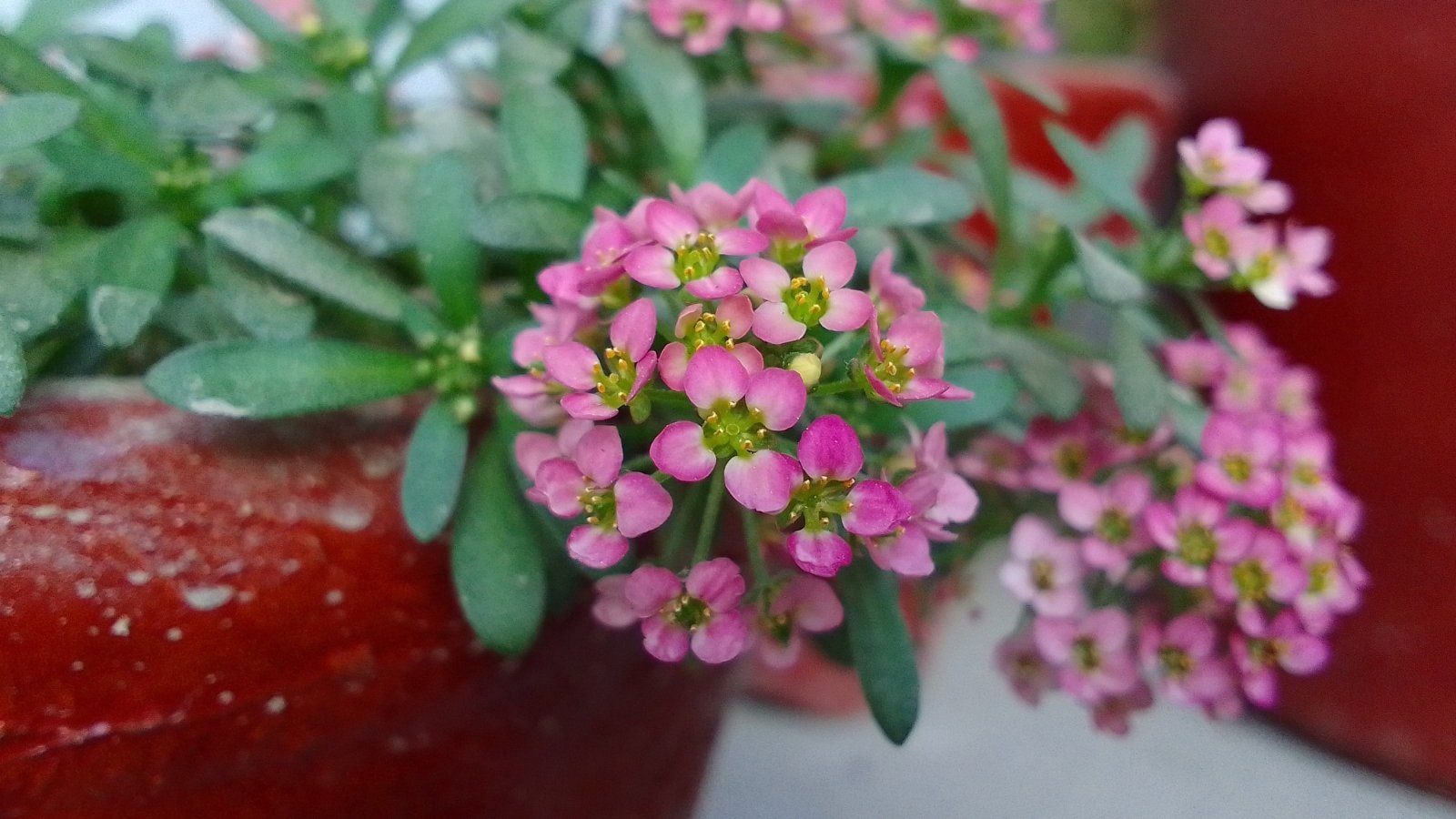
|
botanical name Lobularia maritima |
Sweet alyssum is a sweet-smelling flower that adds airy whimsy into container arrangements. They are delicate plants covered in small white, purple, or pink flowers. I like adding them to arrangements near sitting areas to enjoy their delightful fragrance.
Sweet alyssum won’t take full shade. You will need to find a partly shaded spot for them. I use them as a filler and spiller plant. They really grow and fill and puff over the edges of containers. A simple dracaena filled with sweet alyssum underneath is a perfect arrangement. The hard structure of the spiky dracaena mixed with the soft, airy alyssum is a great combo.
Try ‘Allure Pastel Blend’ if you want to add color to your arrangements. I normally think of alyssum as white, but the colored varieties are lovely. This mix comes in shades of pink, purple, and pale yellow.
Trailing Begonia
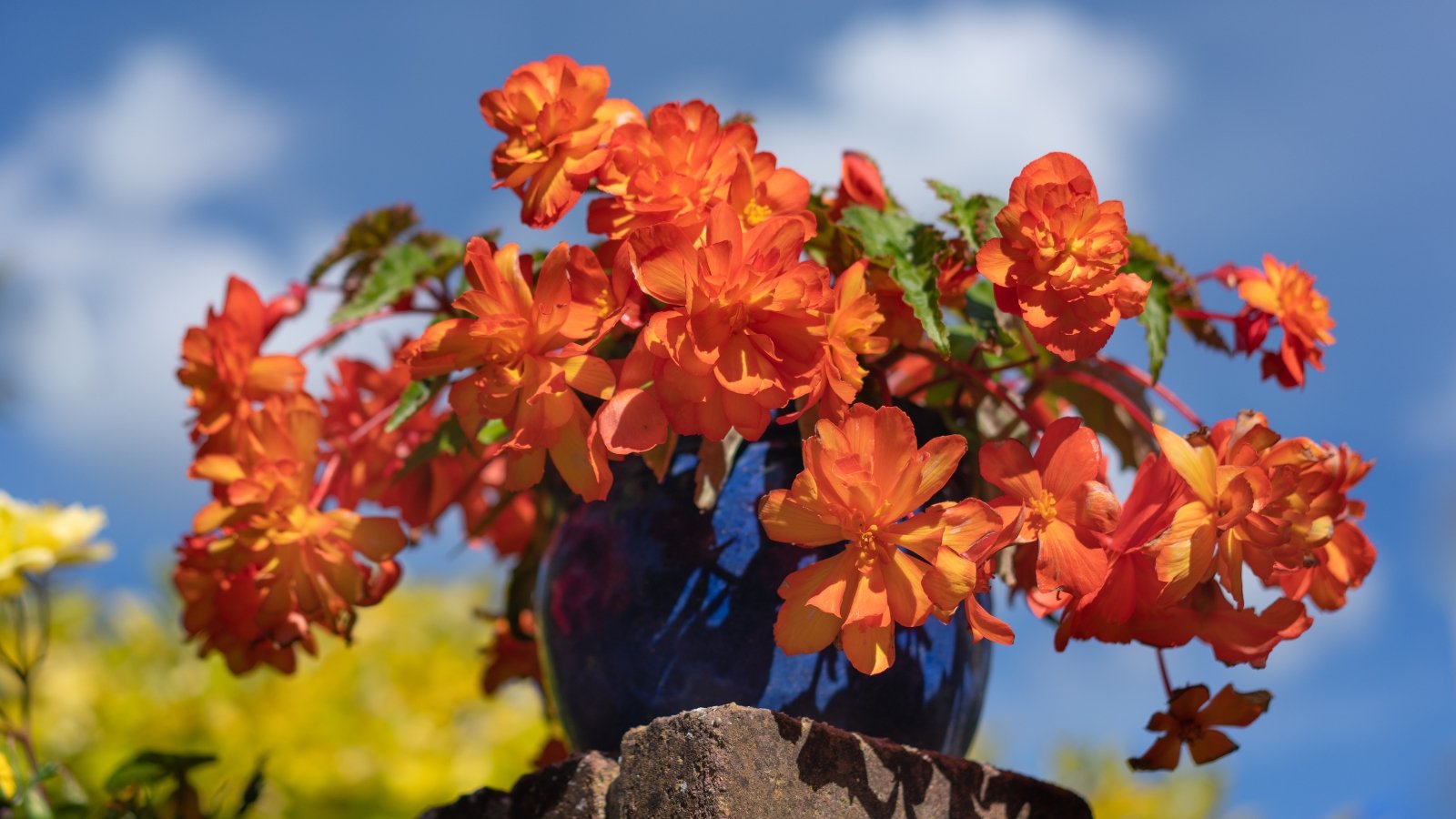
|
botanical name Begonia spp. |
Trailing begonias are technically tuberous begonias. However, the trailing varieties are so different and have a different role in containers, so they get their own category.
Unsurprisingly trailing begonias, well, trail. They have gorgeous flowers that delicately trail over the sides of containers. They also work great in hanging baskets. The big, bold flowers really stand out in shade arrangements. Use a large palm in the center and then add trailing begonias underneath it. They will fill and spill over your container.
‘Fragrant Falls Peach’ is a beautifully peachy-colored trailing begonia. I love this color for containers. Pair it with white alyssum or purple browallia for a whimsical container design.
Torenia
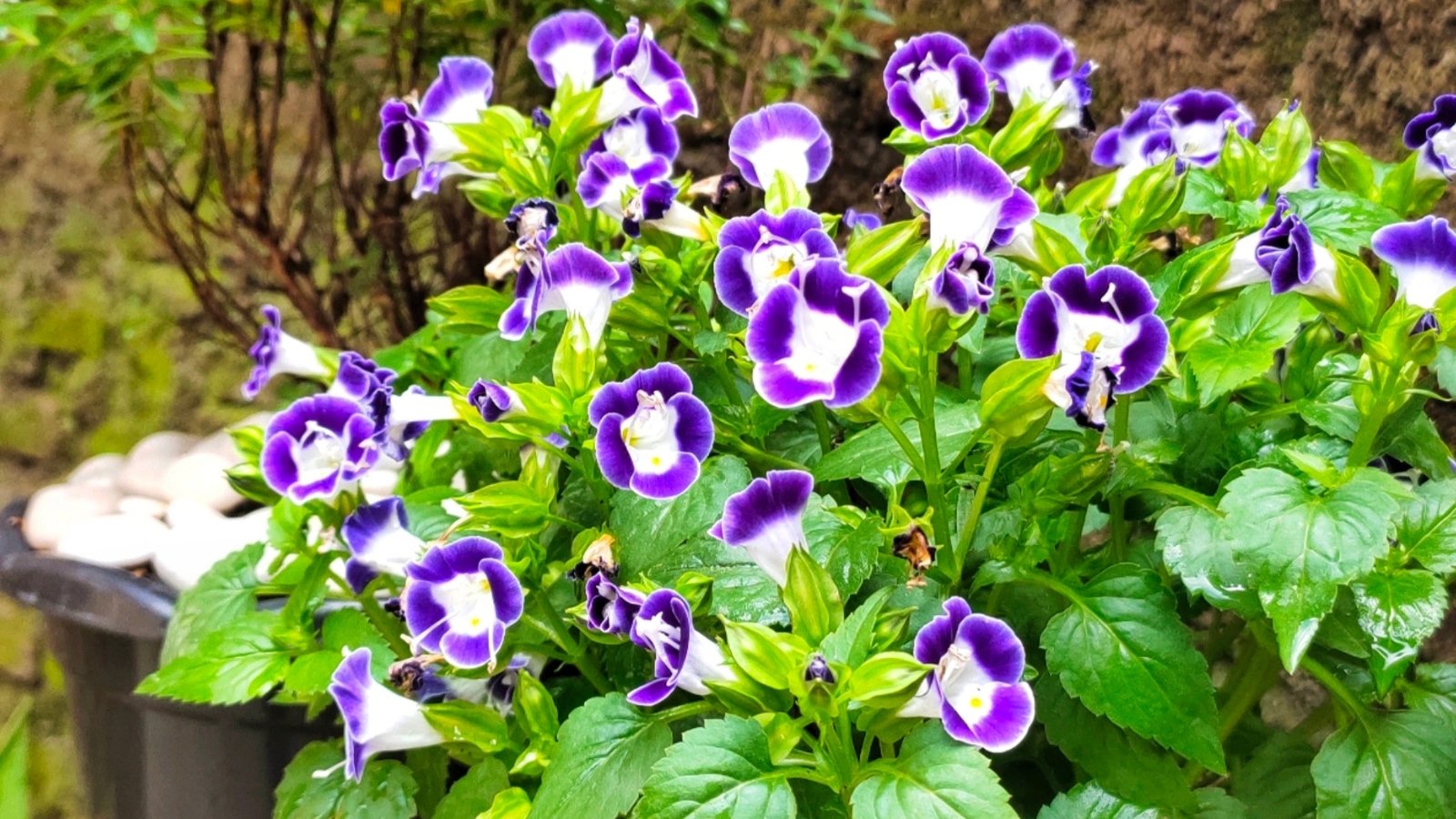
|
botanical name Torenia fournieri |
It’s hard to find flowers that bloom in the shade. That’s why I suggest a lot of colorful foliage plants. But torenia is one of the few flowers that will bloom in the shade (not deep shade). They feature green heart-shaped foliage with small trumpet-shaped flowers that come in a wide variety of colors.
They make a sweet filler plant in containers. I like a simple large hosta with torenia planted underneath. The wide leaf of a hosta next to the small torenia flowers is the perfect juxtaposition. They also look great in hanging baskets and window boxes.
The ‘Catalina’ series from Proven Winners are lovely. ‘Catalina Midnight Blue’ features blue flowers with a yellow spot on them. The petals are deep blue on the margins and fade to a pale purple. They look great on their own or pair them with ‘NonStop Yellow’ begonias to really make their yellow spot pop.
Tuberous Begonia
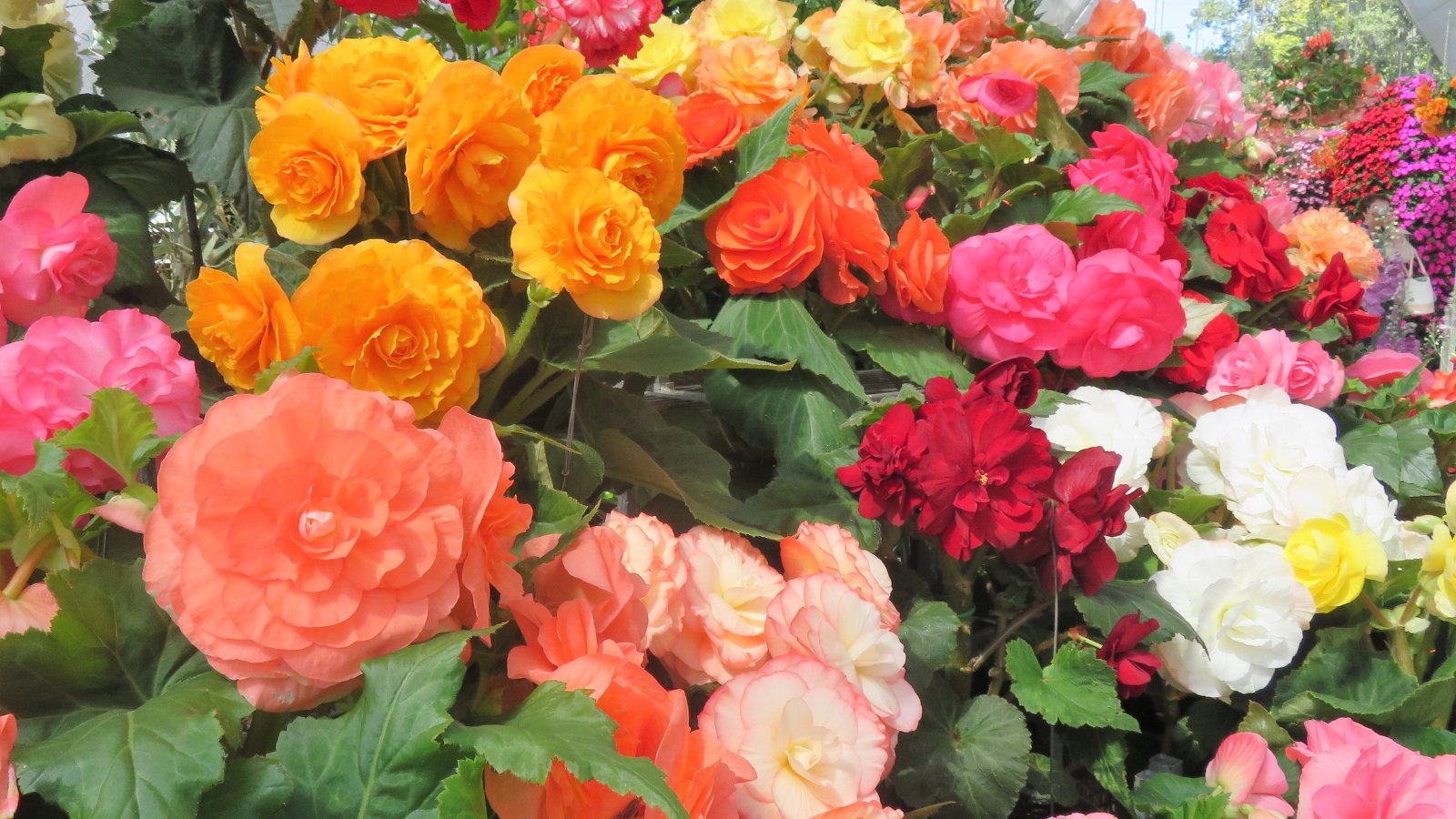
|
botanical name Begonia tuberosa |
Tuberous begonias are show stoppers in shade containers. They have large rosettes of flowers in bright colors.
Tuberous begonias make a great filler plant in mixed containers. You can keep things real simple with an areca palm or elephant ear alocasia. Then plant tuberous begonias underneath. You can add some trailing ivy or creeping Jenny for a completed look.
My favorite varieties of tuberous begonia include bold red ‘Nonstop Red’ or the multicolored ‘Ontop Sunset Shades’ that include a variety of orange, yellow, and red hues.
Wax Begonia
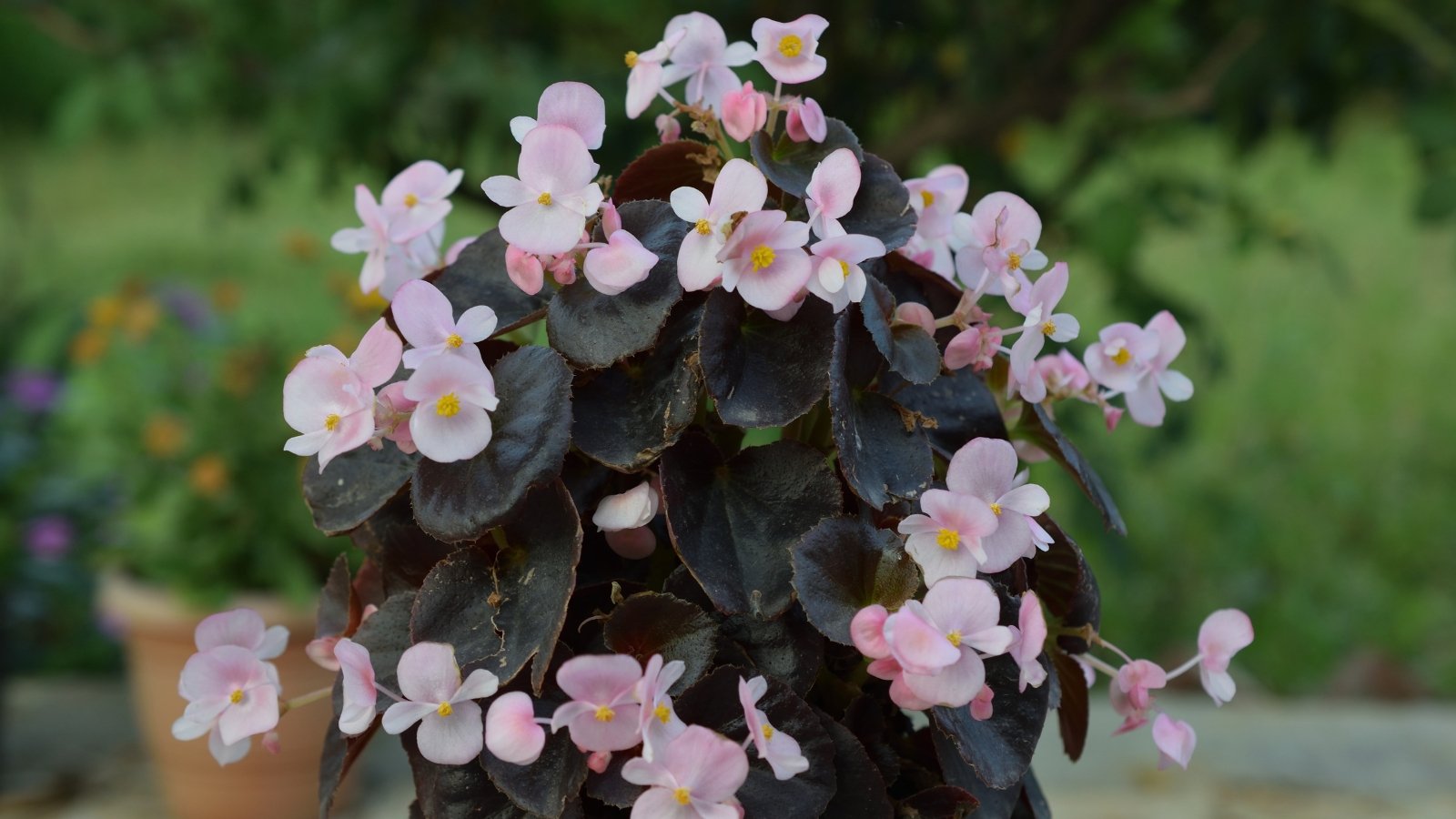
|
botanical name Begonia x semperflorens-cultorum |
Wax, or fibrous, begonias may not be as large and showy as tuberous begonias, but their small size makes them perfect for containers. They have small waxy leaves and clusters of flowers that come in a variety of colors.
Wax begonias are low maintenance and always look good. I like to use them in large containers in areas that don’t receive as much care. Fill a large square concrete planter with wax begonias for an inexpensive and colorful display.
‘Super Olympia Mix’ begonias are small compact plants with lots of flowers. The flowers come in various shades of red, pink, and white. The shades all go together, and it looks like you put a lot of thought into the color palette.
Final Thoughts
Shade containers might seem boring. But as you can see from this list, there are lots of beautiful plants that thrive in the shade! Some have flowers. Others have interesting foliage colors and textures. Have fun mixing and matching these 31 plants to create a visually stunning container.




